Article Review Generator
Here is your article critique :
Writing an article review can become a daunting task for any student. It requires analyzing the article's content, evaluating it, and sharing personal insights. Stuck with summarizing the article rather than criticizing it? Use this article review generator!
- ️🎤 What Is This Review Generator?
- ️👑 Article Review Generator Benefits
- ️🤔 When to Use the Tool
- ️✍️ How to Write an Article Review
- ️❓ Article Review Generator Free: FAQ
- ️🔗 References

🎤 What Is the Article Review Generator?
Our online article review generator is an excellent solution for crafting comprehensive reviews. It offers in-depth analysis while ensuring that the main ideas from the article are effectively highlighted. The tool allows students to focus on critical evaluation and personal insights rather than getting bogged down in summarization.
An article review is a piece that critically evaluates and analyzes a scholarly article or research paper. It involves summarizing the article's main points, assessing its strengths and weaknesses, and providing personal opinion.
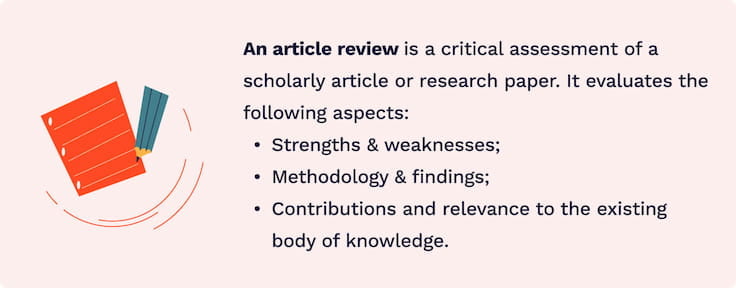
You may need to write an article analysis:
- To provide a critique of a specific article or paper.
- To contribute to academic discourse by evaluating scholarly work.
- To improve your writing skills via summarizing, analyzing, and critiquing complex texts.
- To deepen understanding of a topic.
- To prepare for future research projects.
👑 Online Article Review Generator: 6 Benefits
Many benefits make our article review summary generator stand out. For example, it is:
🤔 When to Use the Article Reviewer Tool?
Our tool is not only helpful in writing article reviews, but it also comes in handy for a variety of other purposes. Here are some cases when you can use the article review summary generator:
- Analyze the article's strengths and weaknesses.
- Quickly understand the key points and arguments of the article.
- Get a new perspective on the article's content and structure.
- Generate a concise summary of an article.
- Understand complex articles more effectively.
- Improve writing skills .
- Be informed about current developments.
- Prepare for exams or presentations.
- Facilitate collaboration during group projects.
- Get multiple article summaries for the literature review.
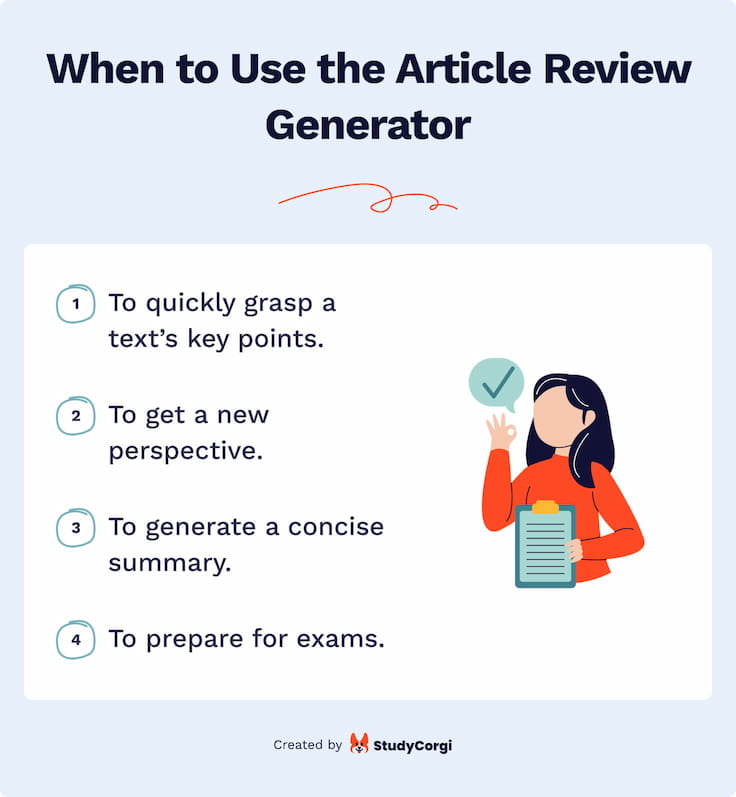
✍️ How to Write an Article Review
You can always use our online article review generator to analyze and evaluate an article quickly. However, if you have time and want to enhance your academic writing skills, you might want to consider writing the review yourself. To help you with this, we've prepared a step-by-step guide for crafting a comprehensive article review .
Step 1 – Preparation
You should clearly understand the task's purpose to prepare for an article review. An article review is more than just a summary or sharing your personal opinion ; it involves a critical analysis and evaluation of the content.
Here are some crucial steps that will help you be fully prepared for writing an article review:
- Assess the title. Before delving into the article, consider what the title suggests about the content and the potential focus of the author's argument.
- Analyze the structure. Subheadings can offer a roadmap of the article's structure and organization. Focus on them to get an overview of the key topics and themes that the author will address.
- Understand the main idea. Identify the central argument or thesis of the article. This is the primary claim or position that the author is asserting.
- Analyze the abstract. The abstract provides a condensed summary of the entire article, offering a glimpse into the main arguments, research methodology, and conclusions.
Step 2 – Reading
Correctly reading an article is essential for making a well-informed evaluation , so don't underestimate this step. Take notes or use highlighters to keep track of the information you might refer to later. We recommend paying attention to:
- Intended audience . Determine who the article is addressing. Consider the level of expertise, interests, and background knowledge the author assumes about the readers.
- Author's purpose. Is the author aiming to summarize existing research, present a new argument, or refute others' claims?
- Key terms. Note whether the author defines key terms or concepts. A clear definition of terms helps in understanding the author's arguments effectively.
- Facts and opinions. Differentiate between factual information and the author's views. Assess the reliability and validity of the information presented.
- Central arguments and conclusions. Assess their clarity, coherence, and the extent to which they are supported by evidence and analysis.
- Methodology and results. Examine the methods and expected results in the article. Assess the credibility of the research and the reported findings' clarity.
- Visual aids. If the article includes illustrations or charts, assess their effectiveness in conveying information and supporting the content.
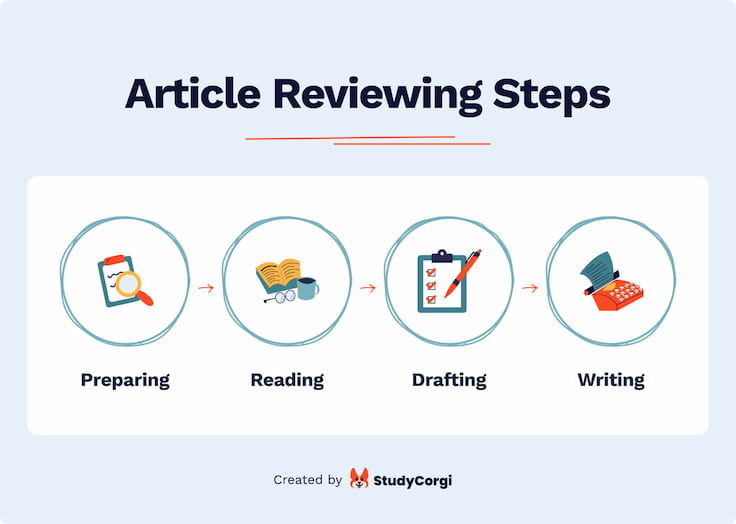
Step 3 – Outlining & Drafting
Creating an outline for an article review can help you organize your ideas and guarantee that your review is well-structured and coherent. Usually, the outline includes an introduction, the body of the review, and a conclusion.
When writing an outline, work on your thesis statement . A thesis statement is a sentence or two that presents the main argument you are making about the article. It is the central point that you will support and develop throughout your review.
After finishing your outline, you can move on to writing a draft. These are the main components for each section of an article review:
- Hook (attention-grabbing opening).
- Background information on the article.
- Thesis statement.
- Summary of the article.
- Analysis and evaluation.
- Restated thesis statement.
- Summary of your main points.
- Final evaluation of the article.
- Suggestions for further research or areas for improvement.
Step 4 – Writing
The final stage of writing an article critique involves reviewing and polishing the draft. It is important to revise the piece and check for any mistakes or inconsistencies. Additionally, we recommend double-checking all citations and references and ensuring they are carefully formatted according to the requirements provided in the assignment.
During the review and polishing process, consider the following:
- Review title. Consider creating a suitable title for the article review if a title is not provided. A good article review title should convey the text's main focus, include keywords, and hint at what readers can expect from the review.
- Reference list. Include a reference list to acknowledge and give credit to the sources you have used in your review. Even if the review only references the article being analyzed, the reference list should include this article.
❓ Article Review Generator Free: FAQ
❓ what is an article review.
An article review critically evaluates and analyzes a scholarly article or research paper. It summarizes the main points, critiques the methodology, and discusses the significance and potential limitations of the work. Article reviews are a common assignment among high school and college students.
❓ How to write an article review?
Writing an article review starts with thorough preparation and understanding of the article's context. Then, carefully read the article to identify critical points and evaluate the author's arguments. Finally, provide a well-reasoned and supported assessment of the article's overall quality and contribution. You can always use our article review generator for the best summary and evaluation.
❓ Where is the literature review in an article?
The literature review in an article is typically situated after the introduction or in the body section. It draws a comprehensive overview of existing research relevant to the article's topic. However, not all article reviews require a literature review. It's better to consult the professor or review guidelines to determine if a literature review is necessary for the specific assignment.
❓ How to start an article review?
To begin an article review, start by introducing the article's title, author, and publication date. Provide a brief overview of the article's main topic and purpose. Consider setting the context by explaining the topic's significance and the article's relevance to the field. Lastly, state your thesis or main argument regarding the article's quality and contribution.
🔗 References
- How to Write an Article Review (with Sample Reviews) - wikiHow
- Research Guides: Introduction to Research: Humanities and Social Sciences: Critical Reviews
- How to Review a Journal Article | University of Illinois Springfield
- Research Guides: Writing Help: The Article Review
- Resources Home 🏠
- Try SciSpace Copilot
- Search research papers
- Add Copilot Extension
- Try AI Detector
- Try Paraphraser
- Try Citation Generator
- April Papers
- June Papers
- July Papers

5 literature review tools to ace your research (+2 bonus tools)

Table of Contents
Your literature review is the lore behind your research paper . It comes in two forms, systematic and scoping , both serving the purpose of rounding up previously published works in your research area that led you to write and finish your own.
A literature review is vital as it provides the reader with a critical overview of the existing body of knowledge, your methodology, and an opportunity for research applications.

Some steps to follow while writing your review:
- Pick an accessible topic for your paper
- Do thorough research and gather evidence surrounding your topic
- Read and take notes diligently
- Create a rough structure for your review
- Synthesis your notes and write the first draft
- Edit and proofread your literature review
To make your workload a little lighter, there are many literature review AI tools. These tools can help you find academic articles through AI and answer questions about a research paper.
Best literature review tools to improve research workflow
A literature review is one of the most critical yet tedious stages in composing a research paper. Many students find it an uphill task since it requires extensive reading and careful organization .
Using some of the best literature review tools listed here, you can make your life easier by overcoming some of the existing challenges in literature reviews. From collecting and classifying to analyzing and publishing research outputs, these tools help you with your literature review and improve your productivity without additional effort or expenses.
1. SciSpace
SciSpace is an AI for academic research that will help find research papers and answer questions about a research paper. You can discover, read, and understand research papers with SciSpace making it an excellent platform for literature review. Featuring a repository with over 270 million research papers, it comes with your AI research assistant called Copilot that offers explanations, summaries , and answers as you read.
Get started now:
Find academic articles through AI
SciSpace has a dedicated literature review tool that finds scientific articles when you search for a question. Based on semantic search, it shows all the research papers relevant for your subject. You can then gather quick insights for all the papers displayed in your search results like methodology, dataset, etc., and figure out all the papers relevant for your research.
Identify relevant articles faster
Abstracts are not always enough to determine whether a paper is relevant to your research question. For starters, you can ask questions to your AI research assistant, SciSpace Copilot to explore the content and better understand the article. Additionally, use the summarize feature to quickly review the methodology and results of a paper and decide if it is worth reading in detail.

Learn in your preferred language
A big barrier non-native English speakers face while conducting a literature review is that a significant portion of scientific literature is published in English. But with SciSpace Copilot, you can review, interact, and learn from research papers in any language you prefer — presently, it supports 75+ languages. The AI will answer questions about a research paper in your mother tongue.
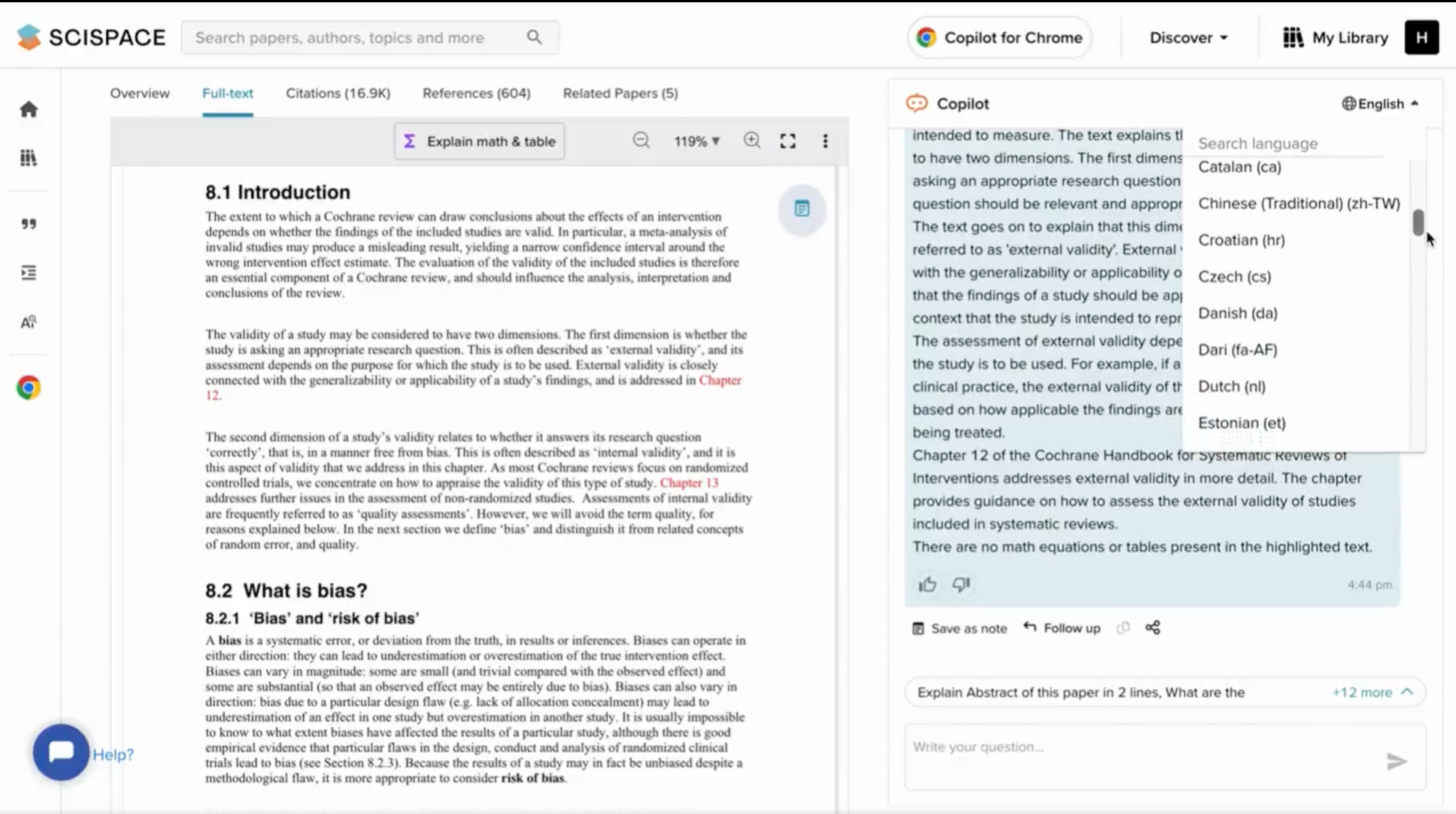
Integrates with Zotero
Many researchers use Zotero to create a library and manage research papers. SciSpace lets you import your scientific articles directly from Zotero into your SciSpace library and use Copilot to comprehend your research papers. You can also highlight key sections, add notes to the PDF as you read, and even turn helpful explanations and answers from Copilot into notes for future review.
Understand math and complex concepts quickly
Come across complex mathematical equations or difficult concepts? Simply highlight the text or select the formula or table, and Copilot will provide an explanation or breakdown of the same in an easy-to-understand manner. You can ask follow-up questions if you need further clarification.

Discover new papers to read without leaving
Highlight phrases or sentences in your research paper to get suggestions for related papers in the field and save time on literature reviews. You can also use the 'Trace' feature to move across and discover connected papers, authors, topics, and more.
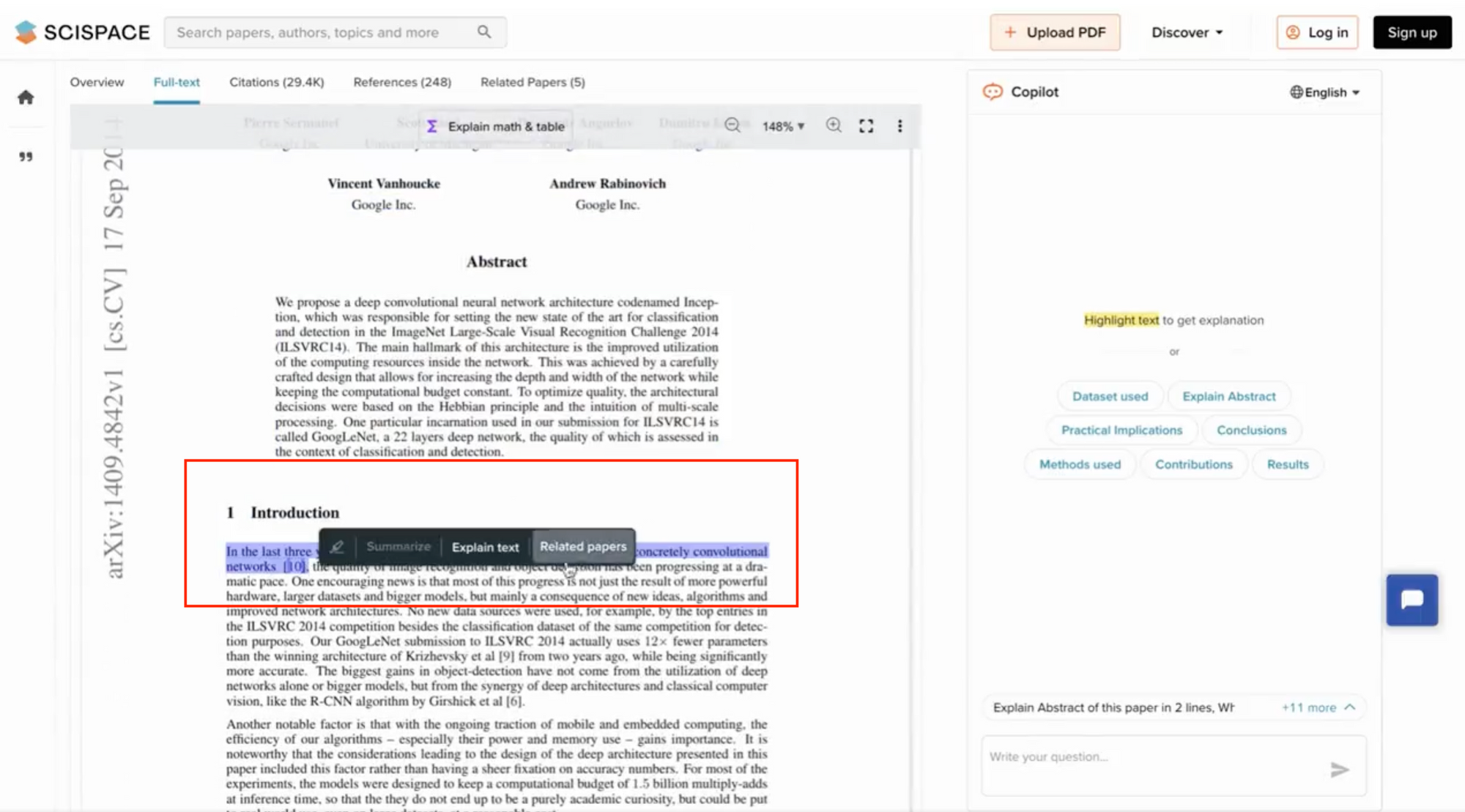
SciSpace Copilot is now available as a Chrome extension , allowing you to access its features directly while you browse scientific literature anywhere across the web.
Get citation-backed answers
When you're conducting a literature review, you want credible information with proper references. Copilot ensures that every piece of information provided by SciSpace Copilot is backed by a direct reference, boosting transparency, accuracy, and trustworthiness.
Ask a question related to the paper you're delving into. Every response from Copilot comes with a clickable citation. This citation leads you straight to the section of the PDF from which the answer was extracted.
By seamlessly integrating answers with citations, SciSpace Copilot assures you of the authenticity and relevance of the information you receive.
2. Mendeley
Mendeley Citation Manager is a free web and desktop application. It helps simplify your citation management workflow significantly. Here are some ways you can speed up your referencing game with Mendeley.
Generate citations and bibliographies
Easily add references from your Mendeley library to your Word document, change your citation style, and create a bibliography, all without leaving your document.
Retrieve references
It allows you to access your references quickly. Search for a term, and it will return results by referencing the year, author, or source.
Add sources to your Mendeley library by dragging PDF to Mendeley Reference Manager. Mendeley will automatically remove the PDF(s) metadata and create a library entry.
Read and annotate documents
It helps you highlight and comment across multiple PDFs while keep them all in one place using Mendeley Notebook . Notebook pages are not tied to a reference and let you quote from many PDFs.
A big part of many literature review workflows, Zotero is a free, open-source tool for managing citations that works as a plug-in on your browser. It helps you gather the information you need, cite your sources, lets you attach PDFs, notes, and images to your citations, and create bibliographies.
Import research articles to your database
Search for research articles on a keyword, and add relevant results to your database. Then, select the articles you are most interested in, and import them into Zotero.
Add bibliography in a variety of formats
With Zotero, you don’t have to scramble for different bibliography formats. Simply use the Zotero-Word plug-in to insert in-text citations and generate a bibliography.
Share your research
You can save a paper and sync it with an online library to easily share your research for group projects. Zotero can be used to create your database and decrease the time you spend formatting citations.
Sysrev is an AI too for article review that facilitates screening, collaboration, and data extraction from academic publications, abstracts, and PDF documents using machine learning. The platform is free and supports public and Open Access projects only.
Some of the features of Sysrev include:
Group labels
Group labels can be a powerful concept for creating database tables from documents. When exported and re-imported, each group label creates a new table. To make labels for a project, go into the manage -> labels section of the project.
Group labels enable project managers to pull table information from documents. It makes it easier to communicate review results for specific articles.
Track reviewer performance
Sysrev's label counting tool provides filtering and visualization options for keeping track of the distribution of labels throughout the project's progress. Project managers can check their projects at any point to track progress and the reviewer's performance.
Tool for concordance
The Sysrev tool for concordance allows project administrators and reviewers to perform analysis on their labels. Concordance is measured by calculating the number of times users agree on the labels they have extracted.
Colandr is a free, open-source, internet-based analysis and screening software used as an AI for academic research. It was designed to ease collaboration across various stages of the systematic review procedure. The tool can be a little complex to use. So, here are the steps involved in working with Colandr.
Create a review
The first step to using Colandr is setting up an organized review project. This is helpful to librarians who are assisting researchers with systematic reviews.
The planning stage is setting the review's objectives along with research queries. Any reviewer can review the details of the planning stage. However, they can only be modified by the author for the review.
Citation screening/import
In this phase, users can upload their results from database searches. Colandr also offers an automated deduplication system.
Full-text screening
The system in Colandr will discover the combination of terms and expressions that are most useful for the reader. If an article is selected, it will be moved to the final step.
Data extraction/export
Colandr data extraction is more efficient than the manual method. It creates the form fields for data extraction during the planning stage of the review procedure. Users can decide to revisit or modify the form for data extraction after completing the initial screening.
Bonus literature review tools
SRDR+ is a web-based tool for extracting and managing systematic review or meta-analysis data. It is open and has a searchable archive of systematic reviews and their data.
7. Plot Digitizer
Plot Digitizer is an efficient tool for extracting information from graphs and images, equipped with many features that facilitate data extraction. The program comes with a free online application, which is adequate to extract data quickly.
Final thoughts
Writing a literature review is not easy. It’s a time-consuming process, which can become tiring at times. The literature review tools mentioned in this blog do an excellent job of maximizing your efforts and helping you write literature reviews much more efficiently. With them, you can breathe a sigh of relief and give more time to your research.
As you dive into your literature review, don’t forget to use SciSpace ResearchGPT to streamline the process. It facilitates your research and helps you explore key findings, summary, and other components of the paper easily.
Frequently Asked Questions (FAQs)
1. what is rrl in research.
RRL stands for Review of Related Literature and sometimes interchanged with ‘Literature Review.’ RRL is a body of studies relevant to the topic being researched. These studies may be in the form of journal articles, books, reports, and other similar documents. Review of related literature is used to support an argument or theory being made by the researcher, as well as to provide information on how others have approached the same topic.
2. What are few softwares and tools available for literature review?
• SciSpace Discover
• Mendeley
• Zotero
• Sysrev
• Colandr
• SRDR+
3. How to generate an online literature review?
The Scispace Discover tool, which offers an excellent repository of millions of peer-reviewed articles and resources, will help you generate or create a literature review easily. You may find relevant information by utilizing the filter option, checking its credibility, tracing related topics and articles, and citing in widely accepted formats with a single click.
4. What does it mean to synthesize literature?
To synthesize literature is to take the main points and ideas from a number of sources and present them in a new way. The goal is to create a new piece of writing that pulls together the most important elements of all the sources you read. Make recommendations based on them, and connect them to the research.
5. Should we write abstract for literature review?
Abstracts, particularly for the literature review section, are not required. However, an abstract for the research paper, on the whole, is useful for summarizing the paper and letting readers know what to expect from it. It can also be used to summarize the main points of the paper so that readers have a better understanding of the paper's content before they read it.
6. How do you evaluate the quality of a literature review?
• Whether it is clear and well-written.
• Whether Information is current and up to date.
• Does it cover all of the relevant sources on the topic.
• Does it provide enough evidence to support its conclusions.
7. Is literature review mandatory?
Yes. Literature review is a mandatory part of any research project. It is a critical step in the process that allows you to establish the scope of your research and provide a background for the rest of your work.
8. What are the sources for a literature review?
• Reports
• Theses
• Conference proceedings
• Company reports
• Some government publications
• Journals
• Books
• Newspapers
• Articles by professional associations
• Indexes
• Databases
• Catalogues
• Encyclopaedias
• Dictionaries
• Bibliographies
• Citation indexes
• Statistical data from government websites
9. What is the difference between a systematic review and a literature review?
A systematic review is a form of research that uses a rigorous method to generate knowledge from both published and unpublished data. A literature review, on the other hand, is a critical summary of an area of research within the context of what has already been published.
Suggested reads!
Types of essays in academic writing Citation Machine Alternatives — A comparison of top citation tools 2023
QuillBot vs SciSpace: Choose the best AI-paraphrasing tool
ChatPDF vs. SciSpace Copilot: Unveiling the best tool for your research
You might also like

Consensus GPT vs. SciSpace GPT: Choose the Best GPT for Research

Literature Review and Theoretical Framework: Understanding the Differences

Types of Essays in Academic Writing - Quick Guide (2024)

10 Best Literature Review Tools for Researchers
This post may contain affiliate links that allow us to earn a commission at no expense to you. Learn more

Boost your research game with these Best Literature Review Tools for Researchers! Uncover hidden gems, organize your findings, and ace your next research paper!
Conducting literature reviews poses challenges for researchers due to the overwhelming volume of information available and the lack of efficient methods to manage and analyze it.
Researchers struggle to identify key sources, extract relevant information, and maintain accuracy while manually conducting literature reviews. This leads to inefficiency, errors, and difficulty in identifying gaps or trends in existing literature.
Advancements in technology have resulted in a variety of literature review tools. These tools streamline the process, offering features like automated searching, filtering, citation management, and research data extraction. They save time, improve accuracy, and provide valuable insights for researchers.
In this article, we present a curated list of the 10 best literature review tools, empowering researchers to make informed choices and revolutionize their systematic literature review process.
Table of Contents
Top 10 Literature Review Tools for Researchers: In A Nutshell (2023)
#1. semantic scholar – a free, ai-powered research tool for scientific literature.
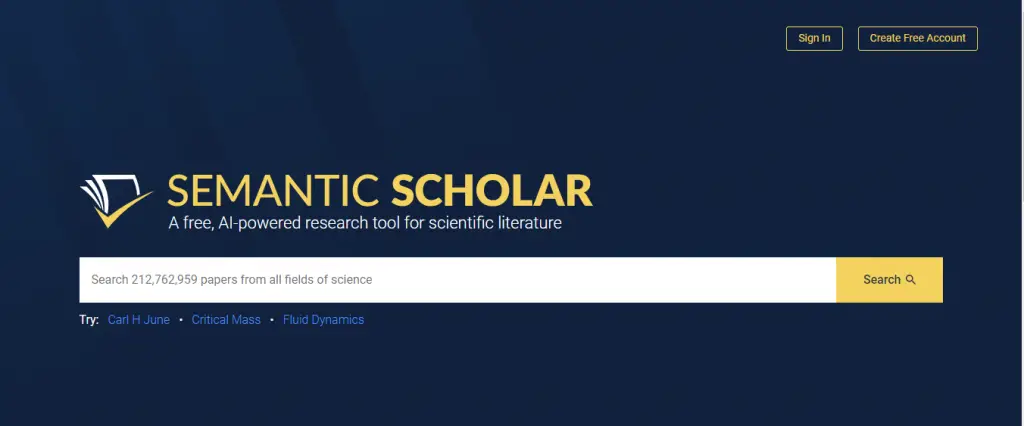
Semantic Scholar is a cutting-edge literature review tool that researchers rely on for its comprehensive access to academic publications. With its advanced AI algorithms and extensive database, it simplifies the discovery of relevant research papers.
By employing semantic analysis, users can explore scholarly articles based on context and meaning, making it a go-to resource for scholars across disciplines.
Additionally, Semantic Scholar offers personalized recommendations and alerts, ensuring researchers stay updated with the latest developments. However, users should be cautious of potential limitations.
Not all scholarly content may be indexed, and occasional false positives or inaccurate associations can occur. Furthermore, the tool primarily focuses on computer science and related fields, potentially limiting coverage in other disciplines.
Researchers should be mindful of these considerations and supplement Semantic Scholar with other reputable resources for a comprehensive literature review. Despite these caveats, Semantic Scholar remains a valuable tool for streamlining research and staying informed.
#2. Elicit – Research assistant using language models like GPT-3
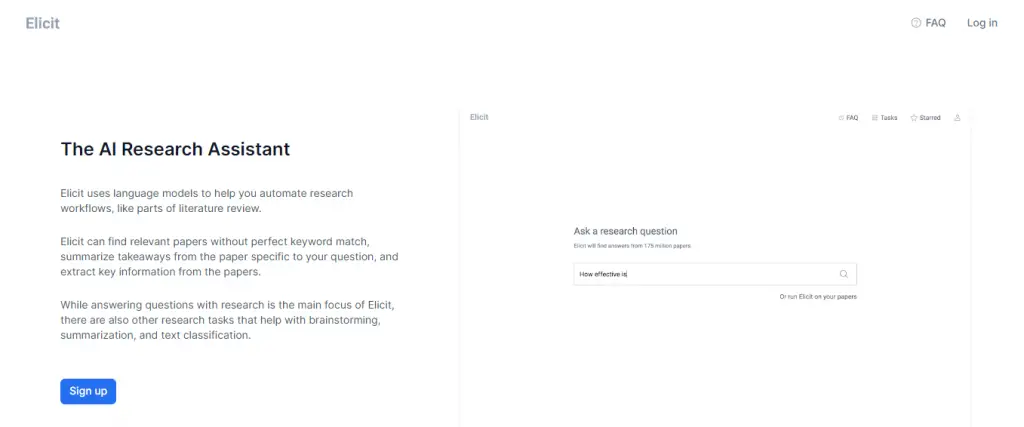
Elicit is a game-changing literature review tool that has gained popularity among researchers worldwide. With its user-friendly interface and extensive database of scholarly articles, it streamlines the research process, saving time and effort.
The tool employs advanced algorithms to provide personalized recommendations, ensuring researchers discover the most relevant studies for their field. Elicit also promotes collaboration by enabling users to create shared folders and annotate articles.
However, users should be cautious when using Elicit. It is important to verify the credibility and accuracy of the sources found through the tool, as the database encompasses a wide range of publications.
Additionally, occasional glitches in the search function have been reported, leading to incomplete or inaccurate results. While Elicit offers tremendous benefits, researchers should remain vigilant and cross-reference information to ensure a comprehensive literature review.
#3. Scite.Ai – Your personal research assistant
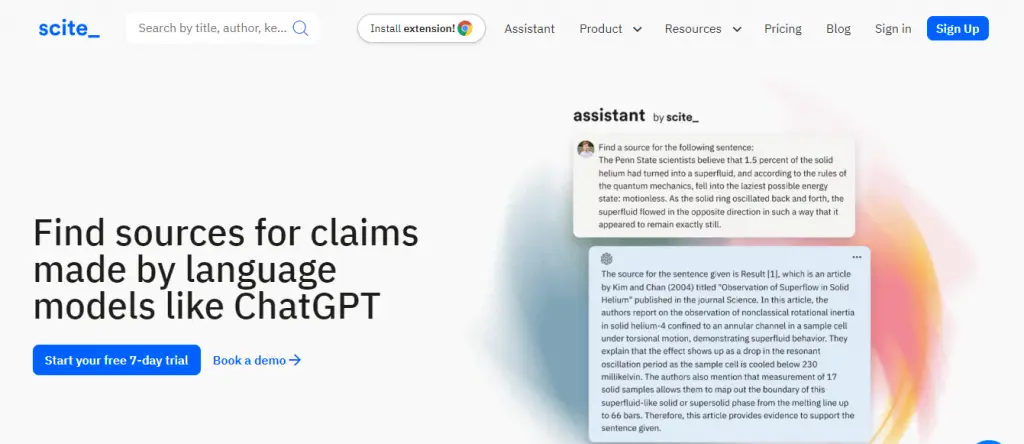
Scite.Ai is a popular literature review tool that revolutionizes the research process for scholars. With its innovative citation analysis feature, researchers can evaluate the credibility and impact of scientific articles, making informed decisions about their inclusion in their own work.
By assessing the context in which citations are used, Scite.Ai ensures that the sources selected are reliable and of high quality, enabling researchers to establish a strong foundation for their research.
However, while Scite.Ai offers numerous advantages, there are a few aspects to be cautious about. As with any data-driven tool, occasional errors or inaccuracies may arise, necessitating researchers to cross-reference and verify results with other reputable sources.
Moreover, Scite.Ai’s coverage may be limited in certain subject areas and languages, with a possibility of missing relevant studies, especially in niche fields or non-English publications.
Therefore, researchers should supplement the use of Scite.Ai with additional resources to ensure comprehensive literature coverage and avoid any potential gaps in their research.
Rayyan offers the following paid plans:
- Monthly Plan: $20
- Yearly Plan: $12
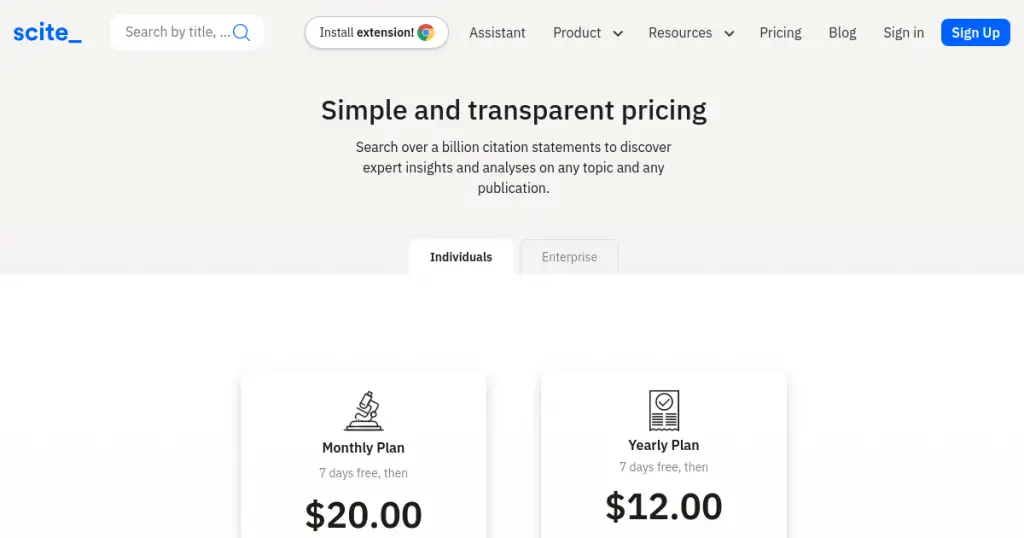
#4. DistillerSR – Literature Review Software
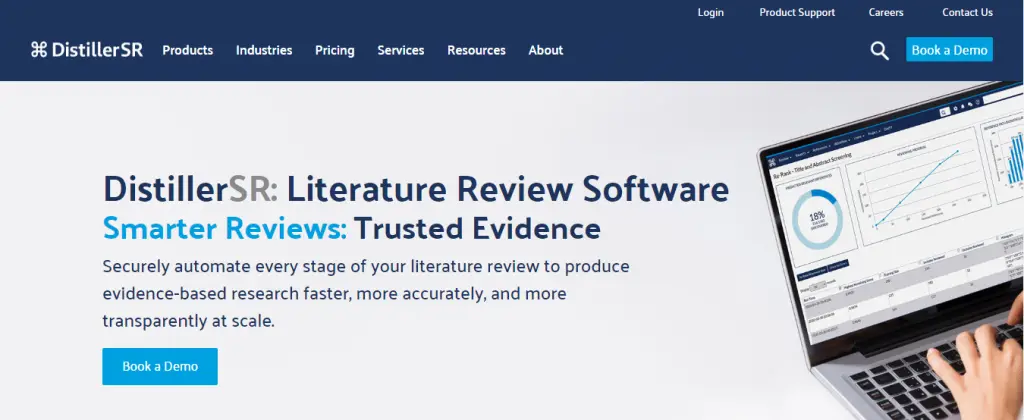
DistillerSR is a powerful literature review tool trusted by researchers for its user-friendly interface and robust features. With its advanced search capabilities, researchers can quickly find relevant studies from multiple databases, saving time and effort.
The tool offers comprehensive screening and data extraction functionalities, streamlining the review process and improving the reliability of findings. Real-time collaboration features also facilitate seamless teamwork among researchers.
While DistillerSR offers numerous advantages, there are a few considerations. Users should invest time in understanding the tool’s features and functionalities to maximize its potential. Additionally, the pricing structure may be a factor for individual researchers or small teams with limited budgets.
Despite occasional technical glitches reported by some users, the developers actively address these issues through updates and improvements, ensuring a better user experience.
Overall, DistillerSR empowers researchers to navigate the vast sea of information, enhancing the quality and efficiency of literature reviews while fostering collaboration among research teams .
#5. Rayyan – AI Powered Tool for Systematic Literature Reviews
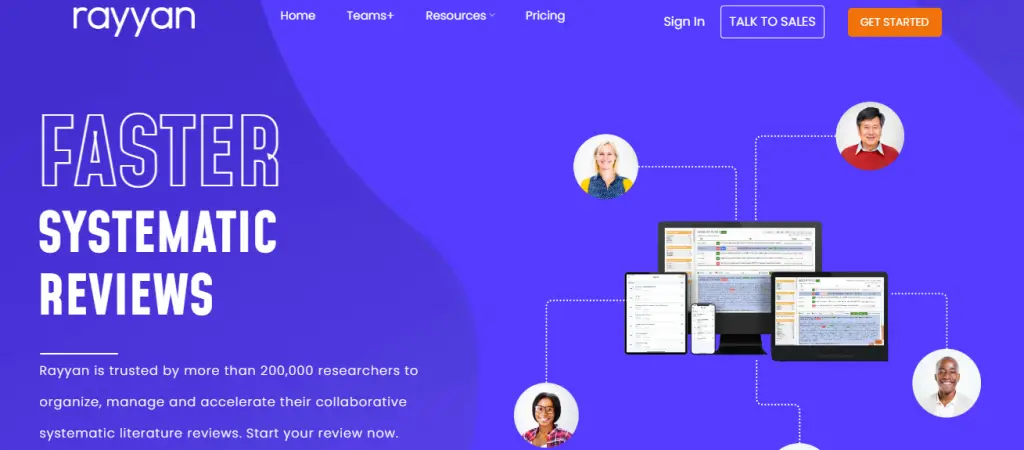
Rayyan is a powerful literature review tool that simplifies the research process for scholars and academics. With its user-friendly interface and efficient management features, Rayyan is highly regarded by researchers worldwide.
It allows users to import and organize large volumes of scholarly articles, making it easier to identify relevant studies for their research projects. The tool also facilitates seamless collaboration among team members, enhancing productivity and streamlining the research workflow.
However, it’s important to be aware of a few aspects. The free version of Rayyan has limitations, and upgrading to a premium subscription may be necessary for additional functionalities.
Users should also be mindful of occasional technical glitches and compatibility issues, promptly reporting any problems. Despite these considerations, Rayyan remains a valuable asset for researchers, providing an effective solution for literature review tasks.
Rayyan offers both free and paid plans:
- Professional: $8.25/month
- Student: $4/month
- Pro Team: $8.25/month
- Team+: $24.99/month
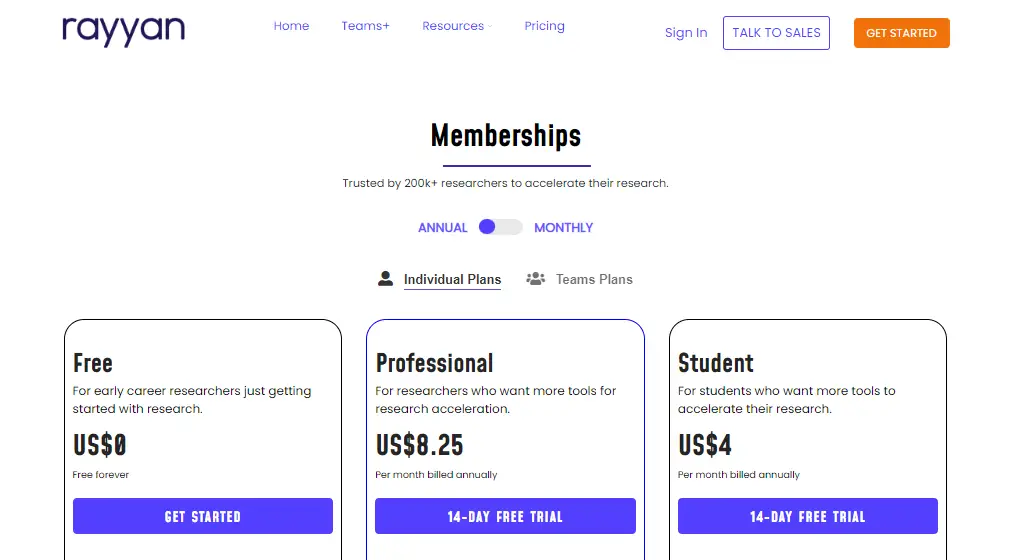
#6. Consensus – Use AI to find you answers in scientific research
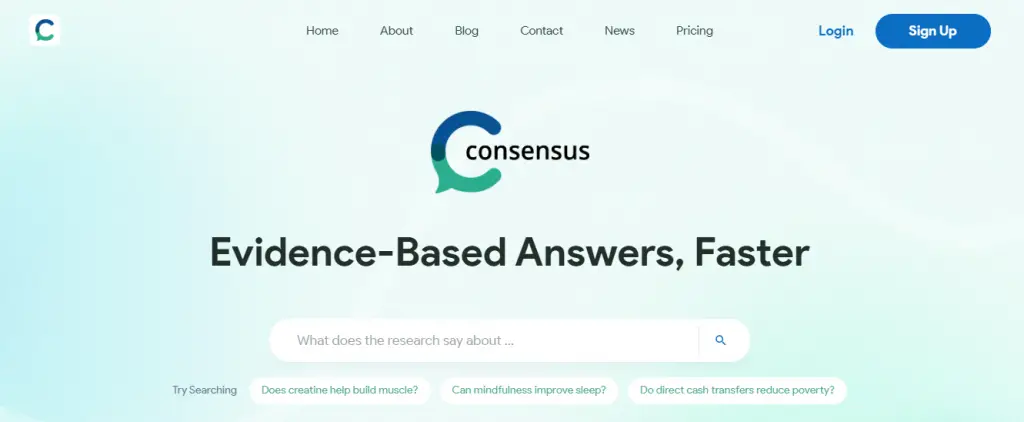
Consensus is a cutting-edge literature review tool that has become a go-to choice for researchers worldwide. Its intuitive interface and powerful capabilities make it a preferred tool for navigating and analyzing scholarly articles.
With Consensus, researchers can save significant time by efficiently organizing and accessing relevant research material.People consider Consensus for several reasons.
Its advanced search algorithms and filters help researchers sift through vast amounts of information, ensuring they focus on the most relevant articles. By streamlining the literature review process, Consensus allows researchers to extract valuable insights and accelerate their research progress.
However, there are a few factors to watch out for when using Consensus. As with any automated tool, researchers should exercise caution and independently verify the accuracy and relevance of the generated results. Complex or niche topics may present challenges, resulting in limited search results. Researchers should also supplement Consensus with manual searches to ensure comprehensive coverage of the literature.
Overall, Consensus is a valuable resource for researchers seeking to optimize their literature review process. By leveraging its features alongside critical thinking and manual searches, researchers can enhance the efficiency and effectiveness of their work, advancing their research endeavors to new heights.
Consensus offers both free and paid plans:
- Premium: $9.99/month
- Enterprise: Custom

#7. RAx – AI-powered reading assistant
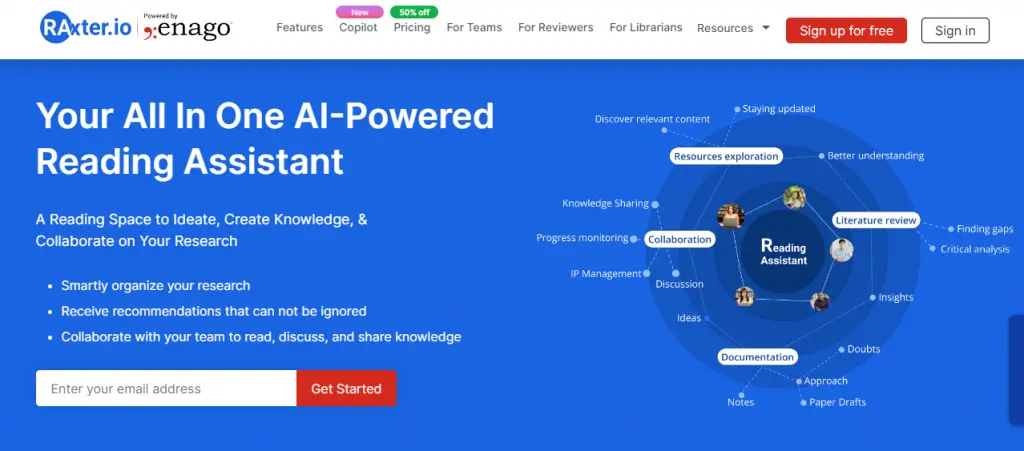
Consensus is a revolutionary literature review tool that has transformed the research process for scholars worldwide. With its user-friendly interface and advanced features, it offers a vast database of academic publications across various disciplines, providing access to relevant and up-to-date literature.
Using advanced algorithms and machine learning, Consensus delivers personalized recommendations, saving researchers time and effort in their literature search.
However, researchers should be cautious of potential biases in the recommendation system and supplement their search with manual verification to ensure a comprehensive review.
Additionally, occasional inaccuracies in metadata have been reported, making it essential for users to cross-reference information with reliable sources. Despite these considerations, Consensus remains an invaluable tool for enhancing the efficiency and quality of literature reviews.
RAx offers both free and paid plans. Currently offering 50% discounts as of July 2023:
- Premium: $6/month $3/month
- Premium with Copilot: $8/month $4/month
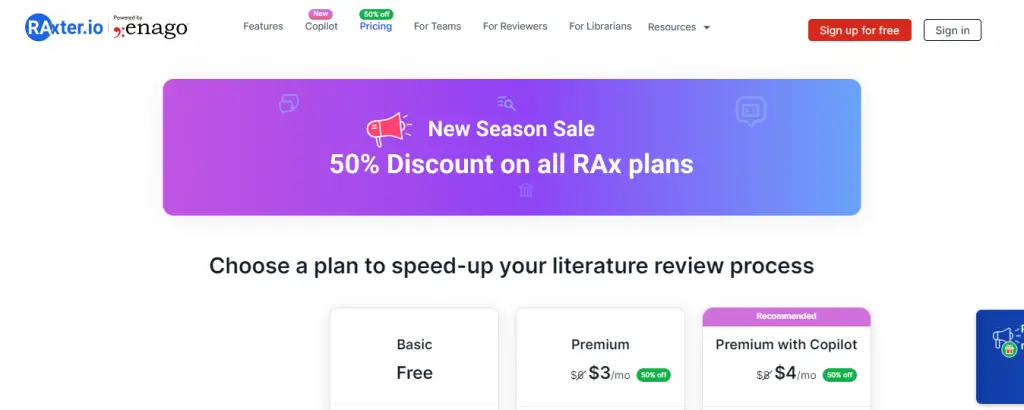
#8. Lateral – Advance your research with AI
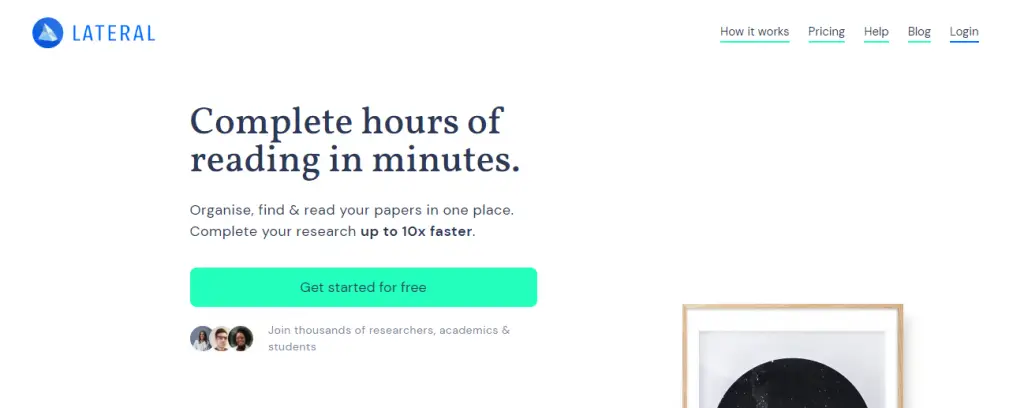
“Lateral” is a revolutionary literature review tool trusted by researchers worldwide. With its user-friendly interface and powerful search capabilities, it simplifies the process of gathering and analyzing scholarly articles.
By leveraging advanced algorithms and machine learning, Lateral saves researchers precious time by retrieving relevant articles and uncovering new connections between them, fostering interdisciplinary exploration.
While Lateral provides numerous benefits, users should exercise caution. It is advisable to cross-reference its findings with other sources to ensure a comprehensive review.
Additionally, researchers must be mindful of potential biases introduced by the tool’s algorithms and should critically evaluate and interpret the results.
Despite these considerations, Lateral remains an indispensable resource, empowering researchers to delve deeper into their fields of study and make valuable contributions to the academic community.
RAx offers both free and paid plans:
- Premium: $10.98
- Pro: $27.46
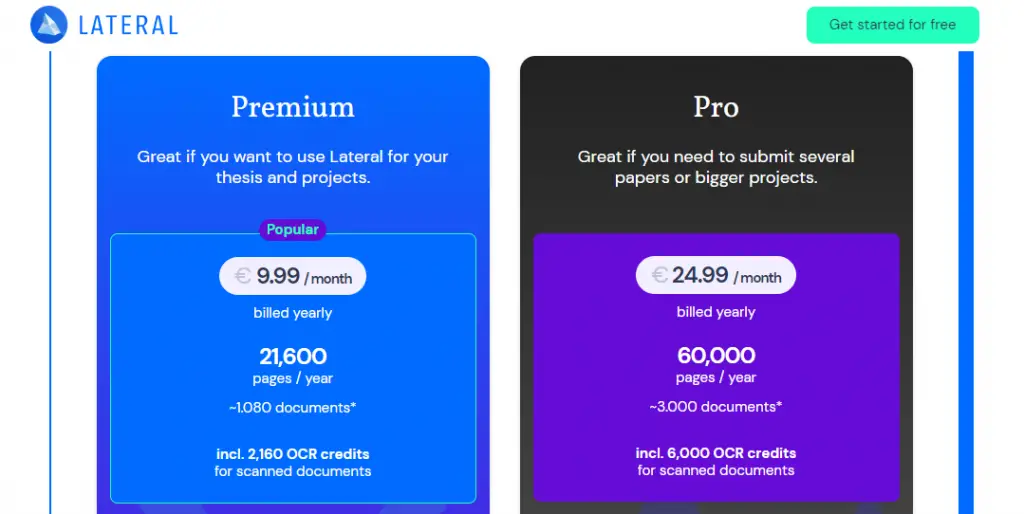
#9. Iris AI – Introducing the researcher workspace
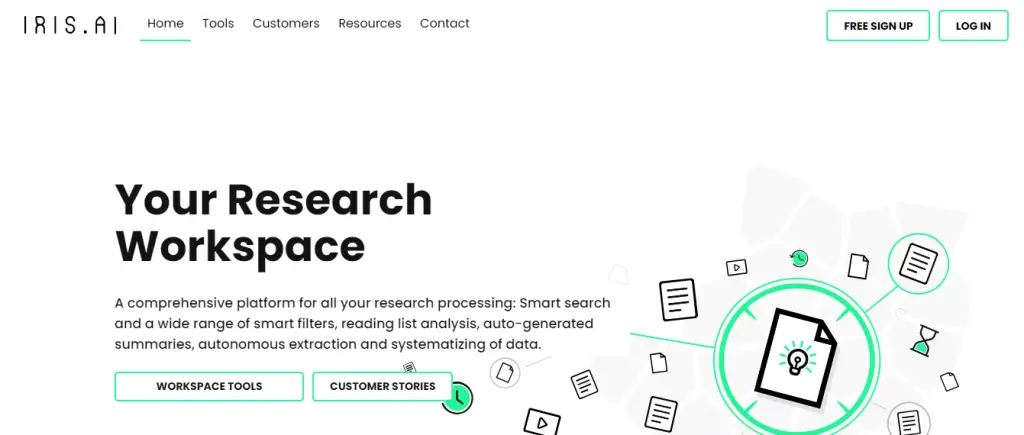
Iris AI is an innovative literature review tool that has transformed the research process for academics and scholars. With its advanced artificial intelligence capabilities, Iris AI offers a seamless and efficient way to navigate through a vast array of academic papers and publications.
Researchers are drawn to this tool because it saves valuable time by automating the tedious task of literature review and provides comprehensive coverage across multiple disciplines.
Its intelligent recommendation system suggests related articles, enabling researchers to discover hidden connections and broaden their knowledge base. However, caution should be exercised while using Iris AI.
While the tool excels at surfacing relevant papers, researchers should independently evaluate the quality and validity of the sources to ensure the reliability of their work.
It’s important to note that Iris AI may occasionally miss niche or lesser-known publications, necessitating a supplementary search using traditional methods.
Additionally, being an algorithm-based tool, there is a possibility of false positives or missed relevant articles due to the inherent limitations of automated text analysis. Nevertheless, Iris AI remains an invaluable asset for researchers, enhancing the quality and efficiency of their research endeavors.
Iris AI offers different pricing plans to cater to various user needs:
- Basic: Free
- Premium: Monthly ($82.41), Quarterly ($222.49), and Annual ($791.07)
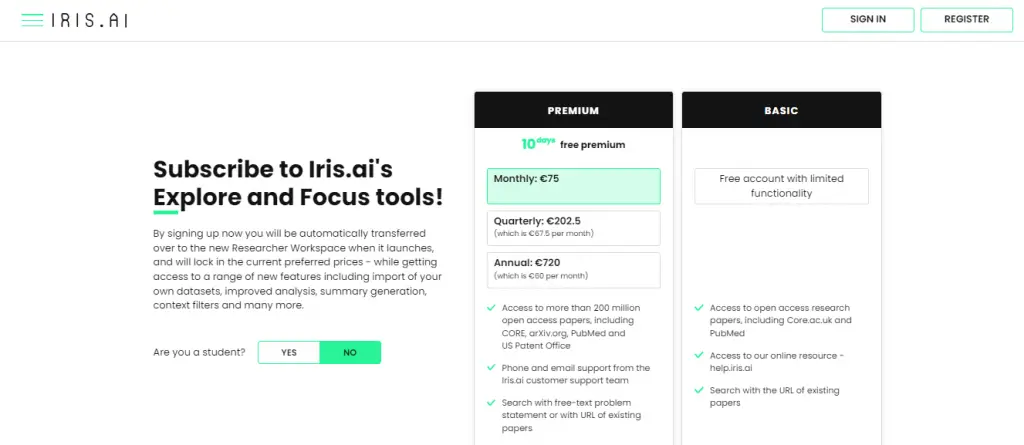
#10. Scholarcy – Summarize your literature through AI
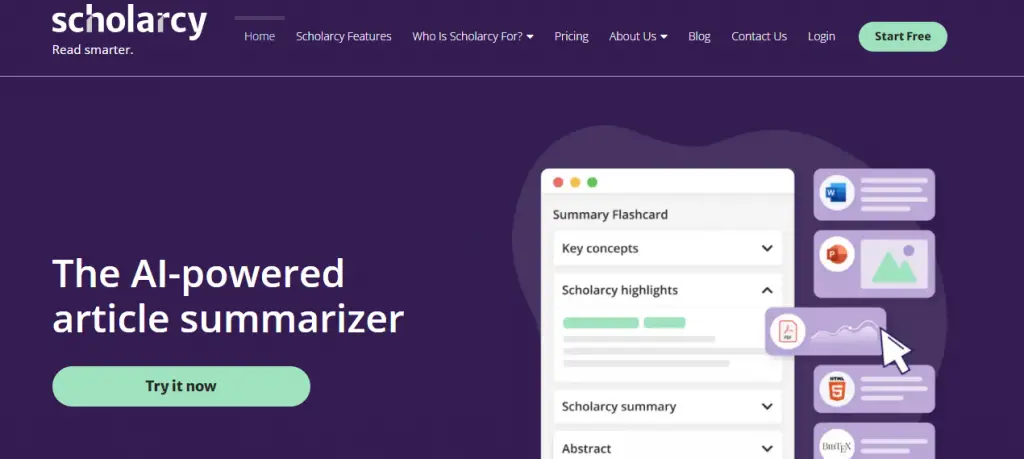
Scholarcy is a powerful literature review tool that helps researchers streamline their work. By employing advanced algorithms and natural language processing, it efficiently analyzes and summarizes academic papers, saving researchers valuable time.
Scholarcy’s ability to extract key information and generate concise summaries makes it an attractive option for scholars looking to quickly grasp the main concepts and findings of multiple papers.
However, it is important to exercise caution when relying solely on Scholarcy. While it provides a useful starting point, engaging with the original research papers is crucial to ensure a comprehensive understanding.
Scholarcy’s automated summarization may not capture the nuanced interpretations or contextual information presented in the full text.
Researchers should also be aware that certain types of documents, particularly those with heavy mathematical or technical content, may pose challenges for the tool.
Despite these considerations, Scholarcy remains a valuable resource for researchers seeking to enhance their literature review process and improve overall efficiency.
Scholarcy offer the following pricing plans:
- Browser Extension and Flashcards: Free
- Personal Library: $9.99
- Academic Institution License: $8K+

Final Thoughts
In conclusion, conducting a comprehensive literature review is a crucial aspect of any research project, and the availability of reliable and efficient tools can greatly facilitate this process for researchers. This article has explored the top 10 literature review tools that have gained popularity among researchers.
Moreover, the rise of AI-powered tools like Iris.ai and Sci.ai promises to revolutionize the literature review process by automating various tasks and enhancing research efficiency.
Ultimately, the choice of literature review tool depends on individual preferences and research needs, but the tools presented in this article serve as valuable resources to enhance the quality and productivity of research endeavors.
Researchers are encouraged to explore and utilize these tools to stay at the forefront of knowledge in their respective fields and contribute to the advancement of science and academia.
Q1. What are literature review tools for researchers?
Literature review tools for researchers are software or online platforms designed to assist researchers in efficiently conducting literature reviews. These tools help researchers find, organize, analyze, and synthesize relevant academic papers and other sources of information.
Q2. What criteria should researchers consider when choosing literature review tools?
When choosing literature review tools, researchers should consider factors such as the tool’s search capabilities, database coverage, user interface, collaboration features, citation management, annotation and highlighting options, integration with reference management software, and data extraction capabilities.
It’s also essential to consider the tool’s accessibility, cost, and technical support.
Q3. Are there any literature review tools specifically designed for systematic reviews or meta-analyses?
Yes, there are literature review tools that cater specifically to systematic reviews and meta-analyses, which involve a rigorous and structured approach to reviewing existing literature. These tools often provide features tailored to the specific needs of these methodologies, such as:
Screening and eligibility assessment: Systematic review tools typically offer functionalities for screening and assessing the eligibility of studies based on predefined inclusion and exclusion criteria. This streamlines the process of selecting relevant studies for analysis.
Data extraction and quality assessment: These tools often include templates and forms to facilitate data extraction from selected studies. Additionally, they may provide features for assessing the quality and risk of bias in individual studies.
Meta-analysis support: Some literature review tools include statistical analysis features that assist in conducting meta-analyses. These features can help calculate effect sizes, perform statistical tests, and generate forest plots or other visual representations of the meta-analytic results.
Reporting assistance: Many tools provide templates or frameworks for generating systematic review reports, ensuring compliance with established guidelines such as PRISMA (Preferred Reporting Items for Systematic Reviews and Meta-Analyses).
Q4. Can literature review tools help with organizing and annotating collected references?
Yes, literature review tools often come equipped with features to help researchers organize and annotate collected references. Some common functionalities include:
Reference management: These tools enable researchers to import references from various sources, such as databases or PDF files, and store them in a central library. They typically allow you to create folders or tags to organize references based on themes or categories.
Annotation capabilities: Many tools provide options for adding annotations, comments, or tags to individual references or specific sections of research articles. This helps researchers keep track of important information, highlight key findings, or note potential connections between different sources.
Full-text search: Literature review tools often offer full-text search functionality, allowing you to search within the content of imported articles or documents. This can be particularly useful when you need to locate specific information or keywords across multiple references.
Integration with citation managers: Some literature review tools integrate with popular citation managers like Zotero, Mendeley, or EndNote, allowing seamless transfer of references and annotations between platforms.
By leveraging these features, researchers can streamline the organization and annotation of their collected references, making it easier to retrieve relevant information during the literature review process.
Leave a Comment Cancel reply
Save my name, email, and website in this browser for the next time I comment.
We maintain and update science journals and scientific metrics. Scientific metrics data are aggregated from publicly available sources. Please note that we do NOT publish research papers on this platform. We do NOT accept any manuscript.
2012-2024 © scijournal.org
- PRO Courses Guides New Tech Help Pro Expert Videos About wikiHow Pro Upgrade Sign In
- EDIT Edit this Article
- EXPLORE Tech Help Pro About Us Random Article Quizzes Request a New Article Community Dashboard This Or That Game Popular Categories Arts and Entertainment Artwork Books Movies Computers and Electronics Computers Phone Skills Technology Hacks Health Men's Health Mental Health Women's Health Relationships Dating Love Relationship Issues Hobbies and Crafts Crafts Drawing Games Education & Communication Communication Skills Personal Development Studying Personal Care and Style Fashion Hair Care Personal Hygiene Youth Personal Care School Stuff Dating All Categories Arts and Entertainment Finance and Business Home and Garden Relationship Quizzes Cars & Other Vehicles Food and Entertaining Personal Care and Style Sports and Fitness Computers and Electronics Health Pets and Animals Travel Education & Communication Hobbies and Crafts Philosophy and Religion Work World Family Life Holidays and Traditions Relationships Youth
- Browse Articles
- Learn Something New
- Quizzes Hot
- This Or That Game
- Train Your Brain
- Explore More
- Support wikiHow
- About wikiHow
- Log in / Sign up
- Education and Communications
- Critical Reviews
How to Write an Article Review (With Examples)
Last Updated: April 24, 2024 Fact Checked
Preparing to Write Your Review
Writing the article review, sample article reviews, expert q&a.
This article was co-authored by Jake Adams . Jake Adams is an academic tutor and the owner of Simplifi EDU, a Santa Monica, California based online tutoring business offering learning resources and online tutors for academic subjects K-College, SAT & ACT prep, and college admissions applications. With over 14 years of professional tutoring experience, Jake is dedicated to providing his clients the very best online tutoring experience and access to a network of excellent undergraduate and graduate-level tutors from top colleges all over the nation. Jake holds a BS in International Business and Marketing from Pepperdine University. There are 12 references cited in this article, which can be found at the bottom of the page. This article has been fact-checked, ensuring the accuracy of any cited facts and confirming the authority of its sources. This article has been viewed 3,098,837 times.
An article review is both a summary and an evaluation of another writer's article. Teachers often assign article reviews to introduce students to the work of experts in the field. Experts also are often asked to review the work of other professionals. Understanding the main points and arguments of the article is essential for an accurate summation. Logical evaluation of the article's main theme, supporting arguments, and implications for further research is an important element of a review . Here are a few guidelines for writing an article review.
Education specialist Alexander Peterman recommends: "In the case of a review, your objective should be to reflect on the effectiveness of what has already been written, rather than writing to inform your audience about a subject."
Article Review 101
- Read the article very closely, and then take time to reflect on your evaluation. Consider whether the article effectively achieves what it set out to.
- Write out a full article review by completing your intro, summary, evaluation, and conclusion. Don't forget to add a title, too!
- Proofread your review for mistakes (like grammar and usage), while also cutting down on needless information.

- Article reviews present more than just an opinion. You will engage with the text to create a response to the scholarly writer's ideas. You will respond to and use ideas, theories, and research from your studies. Your critique of the article will be based on proof and your own thoughtful reasoning.
- An article review only responds to the author's research. It typically does not provide any new research. However, if you are correcting misleading or otherwise incorrect points, some new data may be presented.
- An article review both summarizes and evaluates the article.

- Summarize the article. Focus on the important points, claims, and information.
- Discuss the positive aspects of the article. Think about what the author does well, good points she makes, and insightful observations.
- Identify contradictions, gaps, and inconsistencies in the text. Determine if there is enough data or research included to support the author's claims. Find any unanswered questions left in the article.

- Make note of words or issues you don't understand and questions you have.
- Look up terms or concepts you are unfamiliar with, so you can fully understand the article. Read about concepts in-depth to make sure you understand their full context.

- Pay careful attention to the meaning of the article. Make sure you fully understand the article. The only way to write a good article review is to understand the article.

- With either method, make an outline of the main points made in the article and the supporting research or arguments. It is strictly a restatement of the main points of the article and does not include your opinions.
- After putting the article in your own words, decide which parts of the article you want to discuss in your review. You can focus on the theoretical approach, the content, the presentation or interpretation of evidence, or the style. You will always discuss the main issues of the article, but you can sometimes also focus on certain aspects. This comes in handy if you want to focus the review towards the content of a course.
- Review the summary outline to eliminate unnecessary items. Erase or cross out the less important arguments or supplemental information. Your revised summary can serve as the basis for the summary you provide at the beginning of your review.

- What does the article set out to do?
- What is the theoretical framework or assumptions?
- Are the central concepts clearly defined?
- How adequate is the evidence?
- How does the article fit into the literature and field?
- Does it advance the knowledge of the subject?
- How clear is the author's writing? Don't: include superficial opinions or your personal reaction. Do: pay attention to your biases, so you can overcome them.

- For example, in MLA , a citation may look like: Duvall, John N. "The (Super)Marketplace of Images: Television as Unmediated Mediation in DeLillo's White Noise ." Arizona Quarterly 50.3 (1994): 127-53. Print. [9] X Trustworthy Source Purdue Online Writing Lab Trusted resource for writing and citation guidelines Go to source

- For example: The article, "Condom use will increase the spread of AIDS," was written by Anthony Zimmerman, a Catholic priest.

- Your introduction should only be 10-25% of your review.
- End the introduction with your thesis. Your thesis should address the above issues. For example: Although the author has some good points, his article is biased and contains some misinterpretation of data from others’ analysis of the effectiveness of the condom.

- Use direct quotes from the author sparingly.
- Review the summary you have written. Read over your summary many times to ensure that your words are an accurate description of the author's article.

- Support your critique with evidence from the article or other texts.
- The summary portion is very important for your critique. You must make the author's argument clear in the summary section for your evaluation to make sense.
- Remember, this is not where you say if you liked the article or not. You are assessing the significance and relevance of the article.
- Use a topic sentence and supportive arguments for each opinion. For example, you might address a particular strength in the first sentence of the opinion section, followed by several sentences elaborating on the significance of the point.

- This should only be about 10% of your overall essay.
- For example: This critical review has evaluated the article "Condom use will increase the spread of AIDS" by Anthony Zimmerman. The arguments in the article show the presence of bias, prejudice, argumentative writing without supporting details, and misinformation. These points weaken the author’s arguments and reduce his credibility.

- Make sure you have identified and discussed the 3-4 key issues in the article.

You Might Also Like

- ↑ https://libguides.cmich.edu/writinghelp/articlereview
- ↑ https://www.ncbi.nlm.nih.gov/pmc/articles/PMC4548566/
- ↑ Jake Adams. Academic Tutor & Test Prep Specialist. Expert Interview. 24 July 2020.
- ↑ https://guides.library.queensu.ca/introduction-research/writing/critical
- ↑ https://www.iup.edu/writingcenter/writing-resources/organization-and-structure/creating-an-outline.html
- ↑ https://writing.umn.edu/sws/assets/pdf/quicktips/titles.pdf
- ↑ https://owl.purdue.edu/owl/research_and_citation/mla_style/mla_formatting_and_style_guide/mla_works_cited_periodicals.html
- ↑ https://www.ncbi.nlm.nih.gov/pmc/articles/PMC4548565/
- ↑ https://writingcenter.uconn.edu/wp-content/uploads/sites/593/2014/06/How_to_Summarize_a_Research_Article1.pdf
- ↑ https://www.uis.edu/learning-hub/writing-resources/handouts/learning-hub/how-to-review-a-journal-article
- ↑ https://writingcenter.unc.edu/tips-and-tools/editing-and-proofreading/
About This Article

If you have to write an article review, read through the original article closely, taking notes and highlighting important sections as you read. Next, rewrite the article in your own words, either in a long paragraph or as an outline. Open your article review by citing the article, then write an introduction which states the article’s thesis. Next, summarize the article, followed by your opinion about whether the article was clear, thorough, and useful. Finish with a paragraph that summarizes the main points of the article and your opinions. To learn more about what to include in your personal critique of the article, keep reading the article! Did this summary help you? Yes No
- Send fan mail to authors
Reader Success Stories
Prince Asiedu-Gyan
Apr 22, 2022
Did this article help you?

Sammy James
Sep 12, 2017
Juabin Matey
Aug 30, 2017
Vanita Meghrajani
Jul 21, 2016
Nov 27, 2018

Featured Articles

Trending Articles

Watch Articles

- Terms of Use
- Privacy Policy
- Do Not Sell or Share My Info
- Not Selling Info
Don’t miss out! Sign up for
wikiHow’s newsletter
Your all in one AI-powered Reading Assistant
A Reading Space to Ideate, Create Knowledge, & Collaborate on Your Research
- Smartly organize your research
- Receive recommendations that can not be ignored
- Collaborate with your team to read, discuss, and share knowledge
From Surface-Level Exploration to Critical Reading - All at One Place!
Fine-tune your literature search.
Our AI-powered reading assistant saves time spent on the exploration of relevant resources and allows you to focus more on reading.
Select phrases or specific sections and explore more research papers related to the core aspects of your selections. Pin the useful ones for future references.
Our platform brings you the latest research news, online courses, and articles from magazines/blogs related to your research interests and project work.
Speed up your literature review
Quickly generate a summary of key sections of any paper with our summarizer.
Make informed decisions about which papers are relevant, and where to invest your time in further reading.
Get key insights from the paper, quickly comprehend the paper’s unique approach, and recall the key points.
Bring order to your research projects
Organize your reading lists into different projects and maintain the context of your research.
Quickly sort items into collections and tag or filter them according to keywords and color codes.
Experience the power of sharing by finding all the shared literature at one place
Decode papers effortlessly for faster comprehension
Highlight what is important so that you can retrieve it faster next time
Find Wikipedia explanations for any selected word or phrase
Save time in finding similar ideas across your projects
Collaborate to read with your team, professors, or students
Share and discuss literature and drafts with your study group, colleagues, experts, and advisors. Recommend valuable resources and help each other for better understanding.
Work in shared projects efficiently and improve visibility within your study group or lab members.
Keep track of your team's progress by being constantly connected and engaging in active knowledge transfer by requesting full access to relevant papers and drafts.
Find Papers From Across the World's Largest Repositories

Testimonials
Privacy and security of your research data are integral to our mission..

Everything you add or create on Enago Read is private by default. It is visible only if and when you share it with other users.

You can put Creative Commons license on original drafts to protect your IP. For shared files, Enago Read always maintains a copy in case of deletion by collaborators or revoked access.

We use state-of-the-art security protocols and algorithms including MD5 Encryption, SSL, and HTTPS to secure your data.
RAxter is now Enago Read! Enjoy the same licensing and pricing with enhanced capabilities. No action required for existing customers.
Your all in one AI-powered Reading Assistant
A Reading Space to Ideate, Create Knowledge, and Collaborate on Your Research
- Smartly organize your research
- Receive recommendations that cannot be ignored
- Collaborate with your team to read, discuss, and share knowledge
From Surface-Level Exploration to Critical Reading - All in one Place!
Fine-tune your literature search.
Our AI-powered reading assistant saves time spent on the exploration of relevant resources and allows you to focus more on reading.
Select phrases or specific sections and explore more research papers related to the core aspects of your selections. Pin the useful ones for future references.
Our platform brings you the latest research related to your and project work.
Speed up your literature review
Quickly generate a summary of key sections of any paper with our summarizer.
Make informed decisions about which papers are relevant, and where to invest your time in further reading.
Get key insights from the paper, quickly comprehend the paper’s unique approach, and recall the key points.
Bring order to your research projects
Organize your reading lists into different projects and maintain the context of your research.
Quickly sort items into collections and tag or filter them according to keywords and color codes.
Experience the power of sharing by finding all the shared literature at one place.
Decode papers effortlessly for faster comprehension
Highlight what is important so that you can retrieve it faster next time.
Select any text in the paper and ask Copilot to explain it to help you get a deeper understanding.
Ask questions and follow-ups from AI-powered Copilot.
Collaborate to read with your team, professors, or students
Share and discuss literature and drafts with your study group, colleagues, experts, and advisors. Recommend valuable resources and help each other for better understanding.
Work in shared projects efficiently and improve visibility within your study group or lab members.
Keep track of your team's progress by being constantly connected and engaging in active knowledge transfer by requesting full access to relevant papers and drafts.
Find papers from across the world's largest repositories

Testimonials
Privacy and security of your research data are integral to our mission..

Everything you add or create on Enago Read is private by default. It is visible if and when you share it with other users.

You can put Creative Commons license on original drafts to protect your IP. For shared files, Enago Read always maintains a copy in case of deletion by collaborators or revoked access.

We use state-of-the-art security protocols and algorithms including MD5 Encryption, SSL, and HTTPS to secure your data.
All-in-one Literature Review Software
Start your free trial.
Free MAXQDA trial for Windows and Mac
Your trial will end automatically after 14 days.
MAXQDA The All-in-one Literature Review Software
MAXQDA is the best choice for a comprehensive literature review. It works with a wide range of data types and offers powerful tools for literature review, such as reference management, qualitative, vocabulary, text analysis tools, and more.
Document viewer
Your analysis.
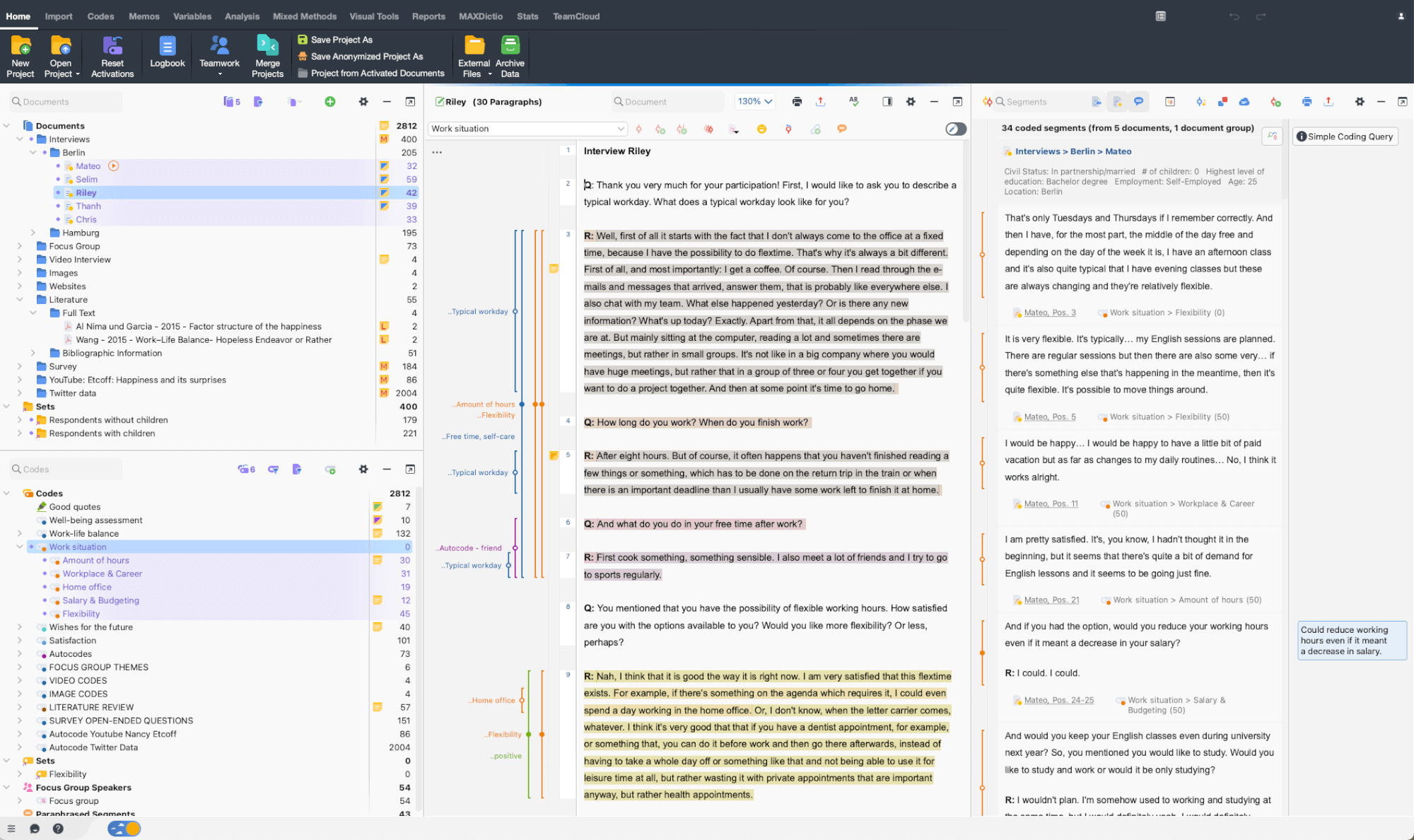
As your all-in-one literature review software, MAXQDA can be used to manage your entire research project. Easily import data from texts, interviews, focus groups, PDFs, web pages, spreadsheets, articles, e-books, and even social media data. Connect the reference management system of your choice with MAXQDA to easily import bibliographic data. Organize your data in groups, link relevant quotes to each other, keep track of your literature summaries, and share and compare work with your team members. Your project file stays flexible and you can expand and refine your category system as you go to suit your research.
Developed by and for researchers – since 1989

Having used several qualitative data analysis software programs, there is no doubt in my mind that MAXQDA has advantages over all the others. In addition to its remarkable analytical features for harnessing data, MAXQDA’s stellar customer service, online tutorials, and global learning community make it a user friendly and top-notch product.
Sally S. Cohen – NYU Rory Meyers College of Nursing
Literature Review is Faster and Smarter with MAXQDA


Easily import your literature review data
With a literature review software like MAXQDA, you can easily import bibliographic data from reference management programs for your literature review. MAXQDA can work with all reference management programs that can export their databases in RIS-format which is a standard format for bibliographic information. Like MAXQDA, these reference managers use project files, containing all collected bibliographic information, such as author, title, links to websites, keywords, abstracts, and other information. In addition, you can easily import the corresponding full texts. Upon import, all documents will be automatically pre-coded to facilitate your literature review at a later stage.
Capture your ideas while analyzing your literature
Great ideas will often occur to you while you’re doing your literature review. Using MAXQDA as your literature review software, you can create memos to store your ideas, such as research questions and objectives, or you can use memos for paraphrasing passages into your own words. By attaching memos like post-it notes to text passages, texts, document groups, images, audio/video clips, and of course codes, you can easily retrieve them at a later stage. Particularly useful for literature reviews are free memos written during the course of work from which passages can be copied and inserted into the final text.

Find concepts important to your generated literature review
When generating a literature review you might need to analyze a large amount of text. Luckily MAXQDA as the #1 literature review software offers Text Search tools that allow you to explore your documents without reading or coding them first. Automatically search for keywords (or dictionaries of keywords), such as important concepts for your literature review, and automatically code them with just a few clicks. Document variables that were automatically created during the import of your bibliographic information can be used for searching and retrieving certain text segments. MAXQDA’s powerful Coding Query allows you to analyze the combination of activated codes in different ways.
Aggregate your literature review
When conducting a literature review you can easily get lost. But with MAXQDA as your literature review software, you will never lose track of the bigger picture. Among other tools, MAXQDA’s overview and summary tables are especially useful for aggregating your literature review results. MAXQDA offers overview tables for almost everything, codes, memos, coded segments, links, and so on. With MAXQDA literature review tools you can create compressed summaries of sources that can be effectively compared and represented, and with just one click you can easily export your overview and summary tables and integrate them into your literature review report.
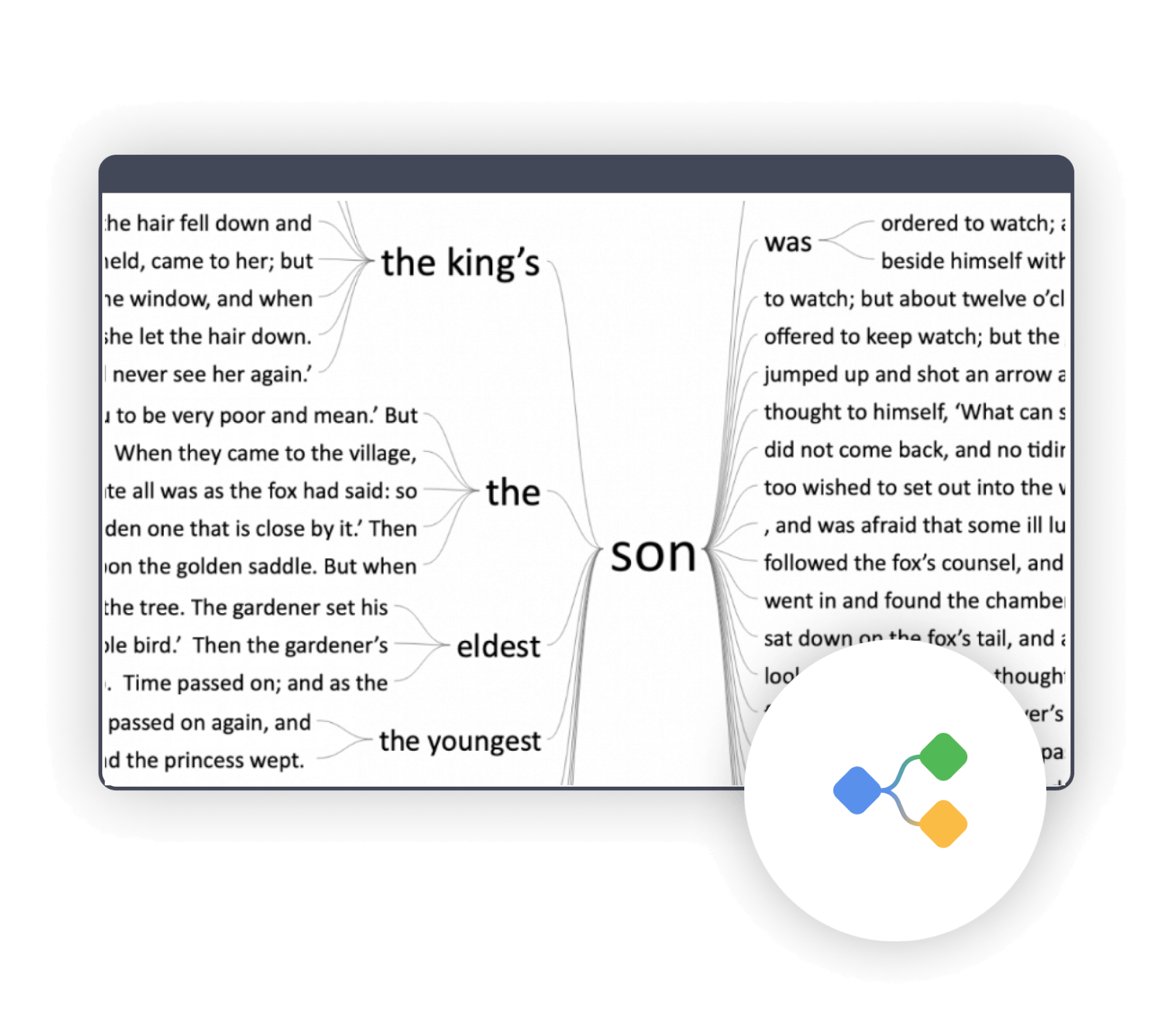
Powerful and easy-to-use literature review tools
Quantitative aspects can also be relevant when conducting a literature review analysis. Using MAXQDA as your literature review software enables you to employ a vast range of procedures for the quantitative evaluation of your material. You can sort sources according to document variables, compare amounts with frequency tables and charts, and much more. Make sure you don’t miss the word frequency tools of MAXQDA’s add-on module for quantitative content analysis. Included are tools for visual text exploration, content analysis, vocabulary analysis, dictionary-based analysis, and more that facilitate the quantitative analysis of terms and their semantic contexts.
Visualize your literature review
As an all-in-one literature review software, MAXQDA offers a variety of visual tools that are tailor-made for qualitative research and literature reviews. Create stunning visualizations to analyze your material. Of course, you can export your visualizations in various formats to enrich your literature review analysis report. Work with word clouds to explore the central themes of a text and key terms that are used, create charts to easily compare the occurrences of concepts and important keywords, or make use of the graphical representation possibilities of MAXMaps, which in particular permit the creation of concept maps. Thanks to the interactive connection between your visualizations with your MAXQDA data, you’ll never lose sight of the big picture.
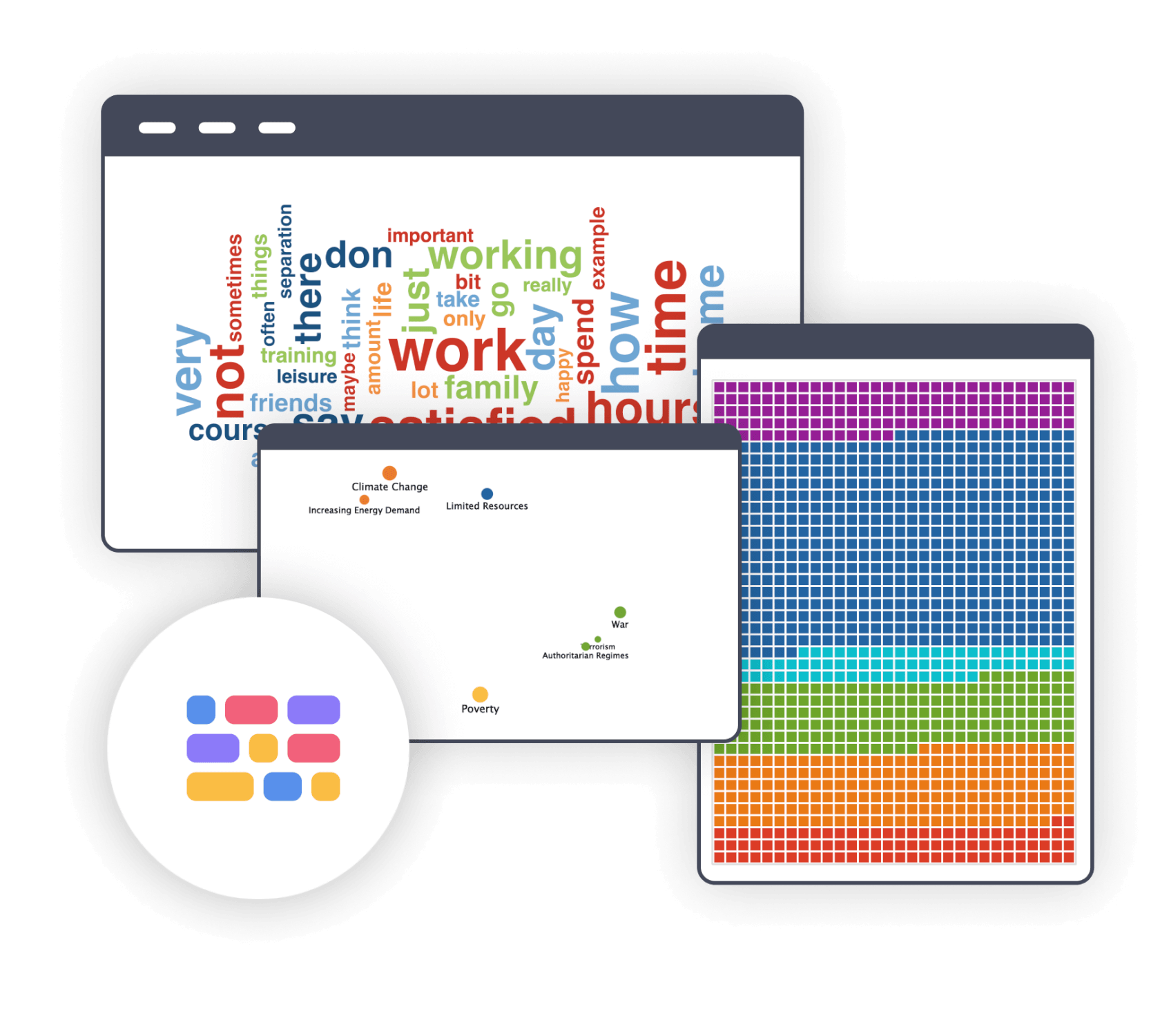
AI Assist: literature review software meets AI
AI Assist – your virtual research assistant – supports your literature review with various tools. AI Assist simplifies your work by automatically analyzing and summarizing elements of your research project and by generating suggestions for subcodes. No matter which AI tool you use – you can customize your results to suit your needs.
Free tutorials and guides on literature review
MAXQDA offers a variety of free learning resources for literature review, making it easy for both beginners and advanced users to learn how to use the software. From free video tutorials and webinars to step-by-step guides and sample projects, these resources provide a wealth of information to help you understand the features and functionality of MAXQDA for literature review. For beginners, the software’s user-friendly interface and comprehensive help center make it easy to get started with your data analysis, while advanced users will appreciate the detailed guides and tutorials that cover more complex features and techniques. Whether you’re just starting out or are an experienced researcher, MAXQDA’s free learning resources will help you get the most out of your literature review.
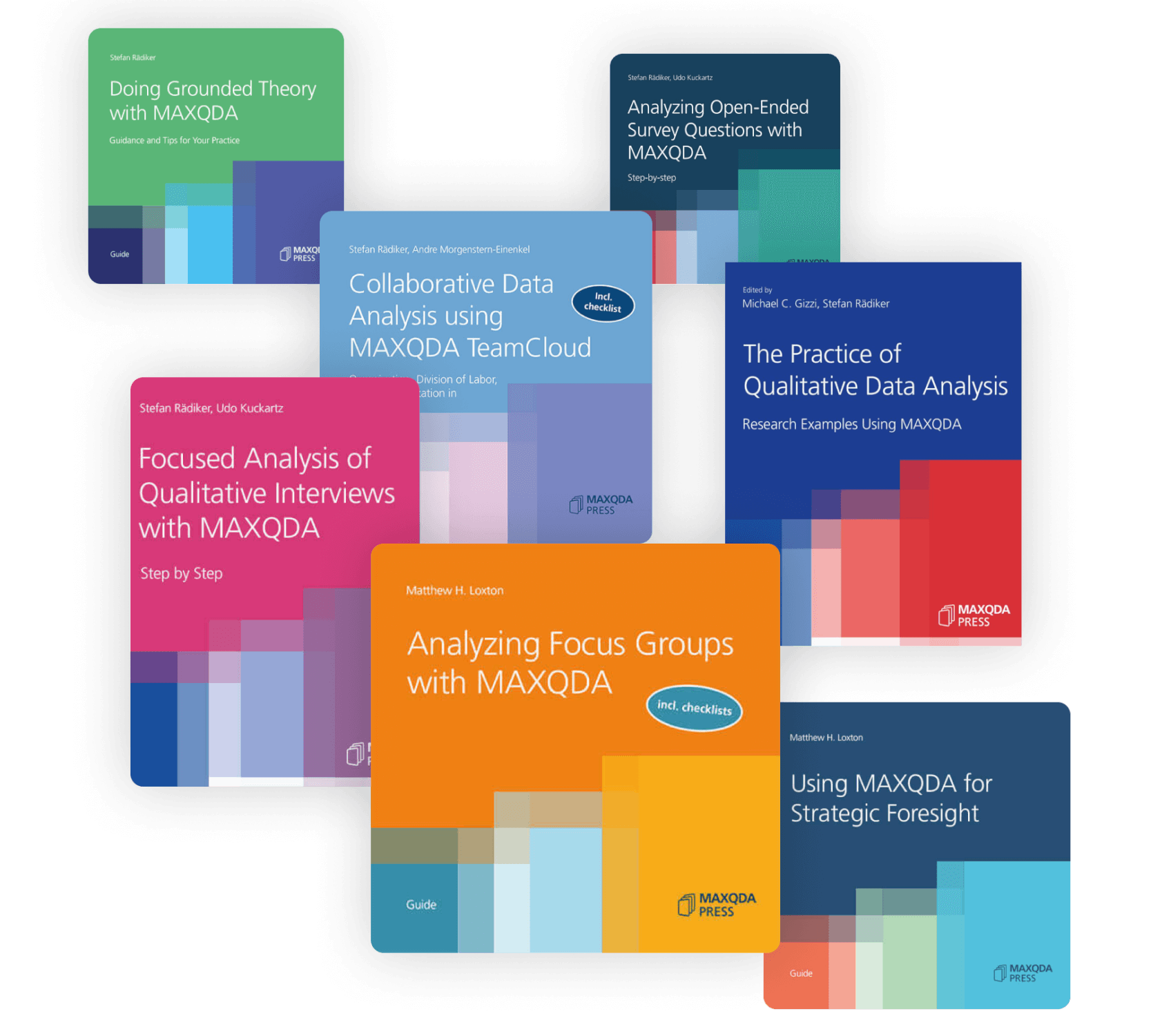
Free MAXQDA Trial for Windows and Mac
Get your maxqda license, compare the features of maxqda and maxqda analytics pro, faq: literature review software.
Literature review software is a tool designed to help researchers efficiently manage and analyze the existing body of literature relevant to their research topic. MAXQDA, a versatile qualitative data analysis tool, can be instrumental in this process.
Literature review software, like MAXQDA, typically includes features such as data import and organization, coding and categorization, advanced search capabilities, data visualization tools, and collaboration features. These features facilitate the systematic review and analysis of relevant literature.
Literature review software, including MAXQDA, can assist in qualitative data interpretation by enabling researchers to organize, code, and categorize relevant literature. This organized data can then be analyzed to identify trends, patterns, and themes, helping researchers draw meaningful insights from the literature they’ve reviewed.
Yes, literature review software like MAXQDA is suitable for researchers of all levels of experience. It offers user-friendly interfaces and extensive support resources, making it accessible to beginners while providing advanced features that cater to the needs of experienced researchers.
Getting started with literature review software, such as MAXQDA, typically involves downloading and installing the software, importing your relevant literature, and exploring the available features. Many software providers offer tutorials and documentation to help users get started quickly.
For students, MAXQDA can be an excellent literature review software choice. Its user-friendly interface, comprehensive feature set, and educational discounts make it a valuable tool for students conducting literature reviews as part of their academic research.
MAXQDA is available for both Windows and Mac users, making it a suitable choice for Mac users looking for literature review software. It offers a consistent and feature-rich experience on Mac operating systems.
When it comes to literature review software, MAXQDA is widely regarded as one of the best choices. Its robust feature set, user-friendly interface, and versatility make it a top pick for researchers conducting literature reviews.
Yes, literature reviews can be conducted without software. However, using literature review software like MAXQDA can significantly streamline and enhance the process by providing tools for efficient data management, analysis, and visualization.
Revolutionize Your Research with Jenni AI
Literature Review Generator
Welcome to Jenni AI, the ultimate tool for researchers and students. Our AI Literature Review Generator is designed to assist you in creating comprehensive, high-quality literature reviews, enhancing your academic and research endeavors. Say goodbye to writer's block and hello to seamless, efficient literature review creation.

Loved by over 1 million academics

Endorsed by Academics from Leading Institutions
Join the Community of Scholars Who Trust Jenni AI

Elevate Your Research Toolkit
Discover the Game-Changing Features of Jenni AI for Literature Reviews
Advanced AI Algorithms
Jenni AI utilizes cutting-edge AI technology to analyze and suggest relevant literature, helping you stay on top of current research trends.
Get started

Idea Generation
Overcome writer's block with AI-generated prompts and ideas that align with your research topic, helping to expand and deepen your review.
Citation Assistance
Get help with proper citation formats to maintain academic integrity and attribute sources correctly.

Our Pledge to Academic Integrity
At Jenni AI, we are deeply committed to the principles of academic integrity. We understand the importance of honesty, transparency, and ethical conduct in the academic community. Our tool is designed not just to assist in your research, but to do so in a way that respects and upholds these fundamental values.
How it Works
Start by creating your account on Jenni AI. The sign-up process is quick and user-friendly.
Define Your Research Scope
Enter the topic of your literature review to guide Jenni AI’s focus.
Citation Guidance
Receive assistance in citing sources correctly, maintaining the academic standard.
Easy Export
Export your literature review to LaTeX, HTML, or .docx formats
Interact with AI-Powered Suggestions
Use Jenni AI’s suggestions to structure your literature review, organizing it into coherent sections.
What Our Users Say
Discover how Jenni AI has made a difference in the lives of academics just like you

· Aug 26
I thought AI writing was useless. Then I found Jenni AI, the AI-powered assistant for academic writing. It turned out to be much more advanced than I ever could have imagined. Jenni AI = ChatGPT x 10.

Charlie Cuddy
@sonofgorkhali
· 23 Aug
Love this use of AI to assist with, not replace, writing! Keep crushing it @Davidjpark96 💪

Waqar Younas, PhD
@waqaryofficial
· 6 Apr
4/9 Jenni AI's Outline Builder is a game-changer for organizing your thoughts and structuring your content. Create detailed outlines effortlessly, ensuring your writing is clear and coherent. #OutlineBuilder #WritingTools #JenniAI

I started with Jenni-who & Jenni-what. But now I can't write without Jenni. I love Jenni AI and am amazed to see how far Jenni has come. Kudos to http://Jenni.AI team.

· 28 Jul
Jenni is perfect for writing research docs, SOPs, study projects presentations 👌🏽

Stéphane Prud'homme
http://jenni.ai is awesome and super useful! thanks to @Davidjpark96 and @whoisjenniai fyi @Phd_jeu @DoctoralStories @WriteThatPhD
Frequently asked questions
What exactly does jenni ai do, is jenni ai suitable for all academic disciplines, is there a trial period or a free version available.
How does Jenni AI help with writer's block?
Can Jenni AI write my literature review for me?
How often is the literature database updated in Jenni AI?
How user-friendly is Jenni AI for those not familiar with AI tools?
Jenni AI: Standing Out From the Competition
In a sea of online proofreaders, Jenni AI stands out. Here’s how we compare to other tools on the market:
Feature Featire
COMPETITORS
Advanced AI-Powered Assistance
Uses state-of-the-art AI technology to provide relevant literature suggestions and structural guidance.
May rely on simpler algorithms, resulting in less dynamic or comprehensive support.
User-Friendly Interface
Designed for ease of use, making it accessible for users with varying levels of tech proficiency.
Interfaces can be complex or less intuitive, posing a challenge for some users.
Transparent and Flexible Pricing
Offers a free trial and clear, flexible pricing plans suitable for different needs.
Pricing structures can be opaque or inflexible, with fewer user options.
Unparalleled Customization
Offers highly personalized suggestions and adapts to your specific research needs over time.
Often provide generic suggestions that may not align closely with individual research topics.
Comprehensive Literature Access
Provides access to a vast and up-to-date range of academic literature, ensuring comprehensive research coverage.
Some may have limited access to current or diverse research materials, restricting the scope of literature reviews.
Ready to Transform Your Research Process?
Don't wait to elevate your research. Sign up for Jenni AI today and discover a smarter, more efficient way to handle your academic literature reviews.

AI Literature Review Generator
Generate high-quality literature reviews fast with ai.
- Academic Research: Create a literature review for your thesis, dissertation, or research paper.
- Professional Research: Conduct a literature review for a project, report, or proposal at work.
- Content Creation: Write a literature review for a blog post, article, or book.
- Personal Research: Conduct a literature review to deepen your understanding of a topic of interest.
New & Trending Tools
Brand architecture and portfolio management tutor, brand identity and positioning tutor, introduction to brand management tutor.
7 open source tools to make literature reviews easy

Opensource.com
A good literature review is critical for academic research in any field, whether it is for a research article, a critical review for coursework, or a dissertation. In a recent article, I presented detailed steps for doing a literature review using open source software .
The following is a brief summary of seven free and open source software tools described in that article that will make your next literature review much easier.
1. GNU Linux
Most literature reviews are accomplished by graduate students working in research labs in universities. For absurd reasons, graduate students often have the worst computers on campus. They are often old, slow, and clunky Windows machines that have been discarded and recycled from the undergraduate computer labs. Installing a flavor of GNU Linux will breathe new life into these outdated PCs. There are more than 100 distributions , all of which can be downloaded and installed for free on computers. Most popular Linux distributions come with a "try-before-you-buy" feature. For example, with Ubuntu you can make a bootable USB stick that allows you to test-run the Ubuntu desktop experience without interfering in any way with your PC configuration. If you like the experience, you can use the stick to install Ubuntu on your machine permanently.
Linux distributions generally come with a free web browser, and the most popular is Firefox . Two Firefox plugins that are particularly useful for literature reviews are Unpaywall and Zotero. Keep reading to learn why.
3. Unpaywall
Often one of the hardest parts of a literature review is gaining access to the papers you want to read for your review. The unintended consequence of copyright restrictions and paywalls is it has narrowed access to the peer-reviewed literature to the point that even Harvard University is challenged to pay for it. Fortunately, there are a lot of open access articles—about a third of the literature is free (and the percentage is growing). Unpaywall is a Firefox plugin that enables researchers to click a green tab on the side of the browser and skip the paywall on millions of peer-reviewed journal articles. This makes finding accessible copies of articles much faster that searching each database individually. Unpaywall is fast, free, and legal, as it accesses many of the open access sites that I covered in my paper on using open source in lit reviews .
Formatting references is the most tedious of academic tasks. Zotero can save you from ever doing it again. It operates as an Android app, desktop program, and a Firefox plugin (which I recommend). It is a free, easy-to-use tool to help you collect, organize, cite, and share research. It replaces the functionality of proprietary packages such as RefWorks, Endnote, and Papers for zero cost. Zotero can auto-add bibliographic information directly from websites. In addition, it can scrape bibliographic data from PDF files. Notes can be easily added on each reference. Finally, and most importantly, it can import and export the bibliography databases in all publishers' various formats. With this feature, you can export bibliographic information to paste into a document editor for a paper or thesis—or even to a wiki for dynamic collaborative literature reviews (see tool #7 for more on the value of wikis in lit reviews).
5. LibreOffice
Your thesis or academic article can be written conventionally with the free office suite LibreOffice , which operates similarly to Microsoft's Office products but respects your freedom. Zotero has a word processor plugin to integrate directly with LibreOffice. LibreOffice is more than adequate for the vast majority of academic paper writing.
If LibreOffice is not enough for your layout needs, you can take your paper writing one step further with LaTeX , a high-quality typesetting system specifically designed for producing technical and scientific documentation. LaTeX is particularly useful if your writing has a lot of equations in it. Also, Zotero libraries can be directly exported to BibTeX files for use with LaTeX.
7. MediaWiki
If you want to leverage the open source way to get help with your literature review, you can facilitate a dynamic collaborative literature review . A wiki is a website that allows anyone to add, delete, or revise content directly using a web browser. MediaWiki is free software that enables you to set up your own wikis.
Researchers can (in decreasing order of complexity): 1) set up their own research group wiki with MediaWiki, 2) utilize wikis already established at their universities (e.g., Aalto University ), or 3) use wikis dedicated to areas that they research. For example, several university research groups that focus on sustainability (including mine ) use Appropedia , which is set up for collaborative solutions on sustainability, appropriate technology, poverty reduction, and permaculture.
Using a wiki makes it easy for anyone in the group to keep track of the status of and update literature reviews (both current and older or from other researchers). It also enables multiple members of the group to easily collaborate on a literature review asynchronously. Most importantly, it enables people outside the research group to help make a literature review more complete, accurate, and up-to-date.
Wrapping up
Free and open source software can cover the entire lit review toolchain, meaning there's no need for anyone to use proprietary solutions. Do you use other libre tools for making literature reviews or other academic work easier? Please let us know your favorites in the comments.

Related Content


- Paste article duplication
- Rewrite suggestion
Suggesting:
Curated advanced toolset.
Write, Rewrite, and Create Engaging Content
AI Article Rewriter
Grammar checker, content generator, video title, video description, tag generator, video ideas, youtube intros, youtube outlines, tweet generator, facebook post, linkedin post, quora answer, ai image generator, our latest blogs.

Top AI Content Creation Tools: Your Guide to Next-...

10 Popular Myths about AI Rewriter Tools Every Wri...

Fatal Mistakes: Are You Using These Incorrect Engl...

How to Paraphrase to Present Old Ideas in New Ways

Best Article Rewriter Tool for Students and Conten...

Online Paraphrasing Tool in Digital Content Writin...
Free article rewriter tool why needed how it works.
What is the purpose of article rewriting and how does the free Article Rewriter Tool help to improve your writing?
Digital Content, Digital Media, and Digital Earnings - these three are today’s most important topics of the web industry. There is no argument over the fact that content is king. Therefore, there should not be any compromises with unique content. But there are already tons of content floating online that we find quite difficult to find our own voice. We know what we want to say, but somehow we cannot figure out the words to say it. This problem becomes more irritating when we need to rewrite a document in a way so it becomes unique and satisfying.
It’s safe to say that a free article rewriter tool is the best way to get great content easily.
Regardless, there are two main ways of approaching this process:
- If you want an expert writer, it is going to cost you a hefty amount.
- Sometimes their writing can’t pass Copyscape or other programs designed to check plagiarism .
- The second way is much easier, simpler, and you do not need to hire anyone for it. You can do it yourself, at home, and with ease.
- Rewritertools.com provides you high-quality, unique content in just a few minutes.
Rewriter tool Uses two different methods to deliver you unique content – The first method – Automatically spins the given content with its powerful article spinner to generate completely original content. The second method – The online reword generator allows you to choose the best synonyms from its enriched database for words and phrases. With this method, you can control how you want your content. Both methods guarantee to provide you unique and unparalleled content material that you can use anywhere. This paraphrasing tool also makes sure that the meaning behind the given content is unaffected in the new material.
Not only that, it is a great tool for aspiring writers for improving their writing.
How to Achieve Top-notch Content with the Free Article Rewriter Tool?
Whether you need content for an online blog , or school essay, to get high-quality content with the article rewriter, you just have to follow these simple steps –
Copy and paste the article you want to rewrite in the free article rewriter tool. Or, you can also write something in the editor box and that will work, as well.
Now choose the “Rewrite” option below the box, and hit ‘enter”. The tool will generate unique content within less than a minute.
Now, if you like the way your content has turned out, click the “Next” option and choose the “Copy” or “Download” option as you like. Just like that, with the paraphrase generator , you now have original and brilliant quality content at your disposal.
After you have done as instructed in Step 2, you should see that the changed words and phrases are highlighted. If you want to change some of the words by yourself, you just have to simply click on the highlighted word. And you will see a group of synonyms for that word from which you can choose the one you like. Or, you can also use a new word by adding the word in the box given in the option.
Just like that, in a single minute, you’ve got your unique content with the help of the free article rewriter tool without losing any sweat. See, how easy it was?
You may use social logins for more fluid experience.
Forgot Password?
Don't have an account? Create an account
Already have an account? Sign in

Adblock Detected
"Your ad-blocker is enabled. Please disabled it to Rewirte Article."
- Word Changer
- Sentence Rewriter
- Plagiarism Remover
- Paragraph Rewriter
0% Complete

How to Use Article Rewriter Tool?
Using our rewriter tool to rewrite texts is very easy and simple. All you have to do is follow the three steps mentioned below:
Upload Article
Copy-paste (CTRL + V) text or upload the file from your device.
Select Mode
Select your required mode.
Start Rewrite
Click the "Rewrite Article" button to rewrite the article.
Article Rewriter Features
Our advanced algorithm rewrites articles without altering their sense or general idea. This AI rewriter tool gives plagiarism-free content with enhanced readability in just a few clicks.
You can check the results given by our article rewriter using any plagiarism checker. The results will come back 100% unique. It can help you rewrite content for blog posts, academics, and marketing by improving the content’s vocabulary. The interface is convenient to use for first-time users with easy to operate options and features. Here's a list of advanced features of this paragraph rewriter:
AI Rewriting
This AI-based sentence rewriter tool uses advanced technology to rewrite each sentence and gives you better options. You just have to upload content, and it will rewrite it automatically with one click.
Simple to use
This free article rewriter is simple to use. With just a few clicks, users can generate unique content that's free of duplicate content . You can rewrite articles on the go without having to register.
Grammatically Perfect Results
The outputs provided by our online paragraph rewriter tool are free from grammatical errors and spelling mistakes. Thanks to the smart AI working, even if there are grammar errors in your input, they will be eliminated when the text is rewritten.
Time Saving Rewriting Tool
Using an Article Rewriter can make life easier. This prevents inefficiency and unnecessary delays. Users can get the results within seconds with this online sentence rewriter.
5 Different Rewriting Modes
Our article rewriting tool comes with five different modes – all of which have a different working. Let’s take a look at each mode in detail:
The Word Changer mode of our essay rewriter is made to target only words in the input text and replace them with their synonyms. It does not change sentence formation or the structure of the overall content. It is best for learning new words and for making light changes to the text.
The Sentence Rewriter mode is made to rewrite sentences of the given text. It alters the structure of the sentences. It can make changes such as converting passive voice into active and replacing phrases with concise words.
The Plagiarism Remover mode of our text rewriter can be used to rewrite text and make it plagiarism-free. If you have any plagiarism in your writing that you need to eliminate, you can use this mode to make the content unique and original.
The AI Rewriter mode utilizes advanced AI algorithms to understand the meaning and context of the given text. With this mode, our article rewriter is able to make heavy changes to the text without altering its original meaning.
The Paragraph Rewriter mode is programmed to make changes at a paragraph level. In other words, it rewrites the content paragraph by paragraph. The mode utilizes AI as well, and it makes smart changes without changing the intent of the text.
Who Can Use Essay Rewriter?
Different Professionals can use this essay rewriter tool for their purpose. Here is a list of the professions in which rewriter tool can be used:
As part of their regular educational schedule, students are expected to use this article rewriter tool to rewrite their essays , assignments, notes, and other educational materials. Plagiarism is a common issue for students and they try to avoid it, as it is closely monitored by universities. An article spinner tool can assist students in avoiding these issues by rewrite text that is unique and free of plagiarism without altering its meaning.
Research work requires information from pre-existing studies, and the chances of similarity are higher. The same concept is true for writers as they must rewrite content based on online researched material . Therefore, the risk of duplication increases. Researchers and writers will no longer have to scratch their heads because a sentence rewriter can be the perfect remedy to deal with duplicated content with just a few clicks.
Blog content should be regularly updated to stay ahead in the rankings. Bloggers have to rewrite sentences to refresh their content so that search engines can recognize it. In this case, a free paragraph rewriter can assist as it provides various options and features to perform as a sentence changer. Bloggers can perform more efficiently by making an effort of hours in just a matter of seconds.
Ranking on search engine result pages is a crucial SEO strategy for everyone. Before ranking a website, Google examines the content to see if it addresses the query of the site's users. Hence, SEO experts can prepare content for their sites with an article spinner. Making content unique and readable with a paragraph rewriter can guarantee its quality on the webpage.
Frequently Asked Question
Which is the best article rewriter?
By comparing results, speed, word count limit, different modes and ease of use, the article rewriter by Articlerewriter.net is the best rewriting tool available online. It's 100% free to use with no daily limits.
Is article rewriting legal?
Article rewriters are used for changing words and for helping in your own research. As far as such uses go, these tools are legal to use. But it is always advised to cite the source of the original content if you happen to borrow some.
How much can you copy without infringing copyright?
Our text rewriter makes your content 100% plagiarism-free, So, the newly generated content is yours. You won’t have to worry about copyright infringement. If you want to copy research material directly, then cite the sources.
What is the importance of rewriting?
The importance of rewriting is in every field. It is important for the following reasons:
- To avoid plagiarism in your content
- Article rewriting helps to improve the quality of the content
- Existing ideas can be re-created using rewriting
How to rewrite an article without changing the meaning?
You can rewrite an article without changing the meaning by replacing the original words with synonyms, altering the sentence structures, breaking and merging sentences and shuffling the order of the content. You can also try our text rewriter to do all of these steps in a single click.
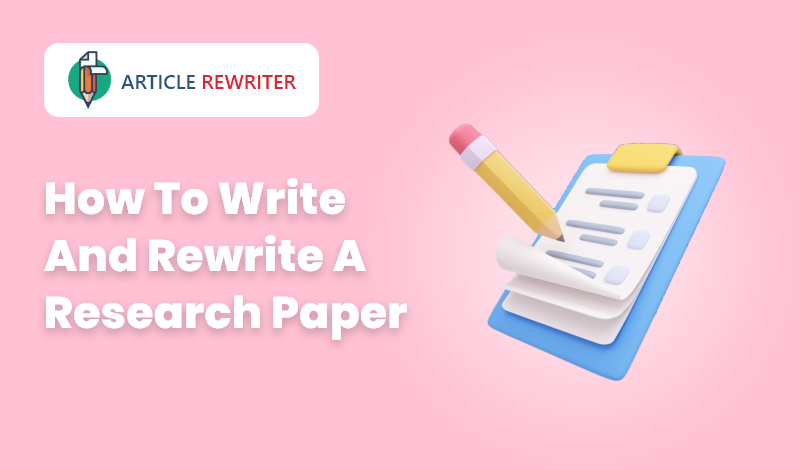
How to Write and Rewrite a Research Paper
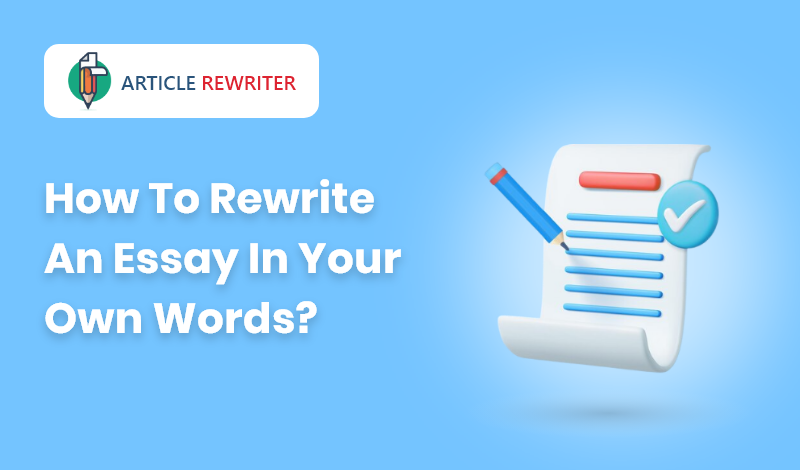
How to Rewrite an Essay in Your Own Words?
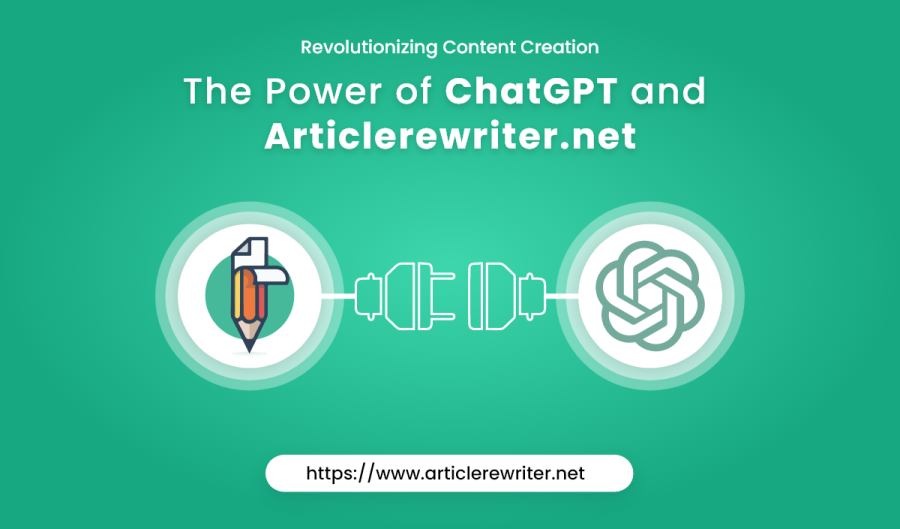
Revolutionizing Content Creation: The Power of ChatGPT and Articlerewriter.net
Please confirm, are you human?

It is easy to create website content by rewriting content. Our website, Article Rewriter, is here to rewrite content on your behalf with ease and speed.

- Email: [email protected]
- Article Rewriter
- Paraphrasing Tool
- Plagiarism Checker
- Grammar Checker
- Summarizer Tool
- Submit your Research
- My Submissions
- Article Guidelines
- Article Guidelines (New Versions)
- Data Guidelines
- Posters and Slides Guidelines
- Document Guidelines
- Article Processing Charges
- Peer Review
- The Peer Review Process
- The Editorial Team’s Role
- Understanding Peer Review Reports and Statuses
- Revising and Responding to Reviewers
Finding Article Reviewers
- Reviewer Criteria
- Hints and Tips for Finding Reviewers
- Dos and Don’ts for Suggesting Reviewers
- Identity transparency: All identities visible
- Reviewer interacts with: Editor, other reviewers, authors
- Review information published: Review reports, submitted manuscript, reviewer identities
- Post publication commenting: Open
- Qualified: Reviewers should typically hold a doctorate (PhD/MD/MBBS or equivalent). Exceptions will be made for scholarly disciplines where doctorates are not necessary (e.g. Education, Library Science), or when an individual has a demonstrable public record of expertise. If possible, when a reviewer suggestion is rejected due to lack of qualifications, the editorial team will suggest that their Principal Investigator/Supervisor is invited instead, and the original person could then take the role of co-reviewer.
- Expert: Reviewers should have published at least three articles as lead author in a relevant topic, with at least one article having been published in the last five years . In fields where a reviewer’s expertise is not typically measured by their publication record or if the suggested reviewer’s expertise is demonstrable in ways other than their publication record, please provide an explanation of their suitability.
- have co-authored with any of the lead authors in the three years preceding publication of Version 1;
- have co-authored with any of the lead authors since the publication of Version 1;
- currently work at the same institution as the authors;
- be a close collaborator with an author.
- Global: For any given article, we require that reviewers are from different institutions . (This does not apply to large, multi-site institutions, such as Max-Planck Institutes or University of California). We also strongly encourage that geographically-diverse reviewers are invited to review, to gain an international perspective on the article. In cases where we receive multiple reviewer suggestions from the same country, the editorial team can only invite one of these reviewers at a time. Providing a geographically-diverse set of reviewers will help to prevent delays to the peer review process.
- Use the authors of the references cited in your article as a starting point for finding reviewers working in your specific field.
- Search abstracting and indexing databases such as Google Scholar , PubMed , Web of Science * and Scopus * (or other subject-specific literature databases) for recent articles with specific keywords can help you to identify authors currently working in the same field as yourself, and who may be suitable to review your article. As an expert in your area of research, you will likely be aware of prominent laboratories whose staff may be suitable to review your articles - try searching their website for potential reviewers. You can also search for specific experts with whom you have no recent collaborations, as they or their postdocs may be suitable to review.
- Try the Journal/Author Name Estimator and other similar tools can help to identify authors who have published related articles.
- Use our Reviewer Finder Tool. This tool analyzes the submission and provides a ranked list of reviewer candidates based on leading authors of related published studies. Authors can access this tool via the 'Suggest Reviewers' link next to submitted and published articles in the Submissions section in My Research . As this is an automatically generated list of potential reviewers, authors must use their own judgement to determine if the suggested reviewers have the appropriate expertise to review the article.
- Make sure suggested reviewers are experts in the relevant subject area F1000Research will only invite reviewers who have expertise in the field of research covered by the article. Not only does this ensure thorough peer review, but also reviewers are more likely to agree to provide a report when the subject matter is close to their own area of expertise.
- Try and ensure a global spread of reviewers For any given article, the reviewers must come from separate institutions and should not be affiliated with the authors’ institutions. We also strongly encourage that reviewers from around the world are invited to review where possible so that a global perspective can be gained for the article, and to ensure that all aspects of the work are reviewed.
- Ensure reviewers from the algorithm are suitable before approving them To provide authors who wish to suggest reviewers with a shortlist, each article is scanned by our Reviewer Finder Tool, which automatically provides a list of researchers who have published related articles. Authors can suggest appropriate reviewers from this automatically generated list (which can be accessed via the ‘Suggest Reviewers’ link next to your submitted or published article in My Research ), but must use their own judgement to determine if the suggested reviewers have the appropriate expertise to review the article.
- Discuss with your co-authors It may be that your co-authors would like to suggest reviewers – only the submitting author is able to provide these, however we welcome suggestions on your other authors’ behalfs. We would also be happy to change the submitting author so that a co-author can submit reviewers directly, please contact the editorial team if you wish to do this.
- Contact us if you have any questions If we have rejected a reviewer who you believe to be suitable, or if you have any questions or concerns about our reviewer criteria, we are always happy to discuss. Please email us so that we can explore possible options.
- Suggest reviewers who have recently closely collaborated with you or your co-authors We consider this to be a potential conflict of interest. A reviewer should not be based at the same institution as any author, be a close collaborator, or have co-authored with any of the lead authors for three years before the publication of the article. Please note that we make exceptions for cases where researchers have published together on the findings or consensus from a large consortia.
- Suggest reviewers who do not have the right expertise The editorial team will not invite reviewers who do not appear to have appropriate expertise. Suggesting inappropriate reviewers can cause significant delays to the peer review process.
- Contact the reviewers directly To ensure a fair peer review process is maintained, the editorial team acts as the intermediary between authors and reviewers. By directly contacting the reviewers, authors could not only influence their assessment of the article, but could also dissuade them from reviewing. Please be aware that if evidence of an author coercing reviewers is brought to our attention, we will investigate and take appropriate action. Authors can respond to a peer review report by posting a comment under the report.
The email address should be the one you originally registered with F1000.
You registered with F1000 via Google, so we cannot reset your password.
To sign in, please click here .
If you still need help with your Google account password, please click here .
You registered with F1000 via Facebook, so we cannot reset your password.
If you still need help with your Facebook account password, please click here .
If your email address is registered with us, we will email you instructions to reset your password.
If you think you should have received this email but it has not arrived, please check your spam filters and/or contact for further assistance.
Thank you for visiting nature.com. You are using a browser version with limited support for CSS. To obtain the best experience, we recommend you use a more up to date browser (or turn off compatibility mode in Internet Explorer). In the meantime, to ensure continued support, we are displaying the site without styles and JavaScript.
- View all journals
- Explore content
- About the journal
- Publish with us
- Sign up for alerts
- 29 April 2024
How reliable is this research? Tool flags papers discussed on PubPeer
- Dalmeet Singh Chawla
You can also search for this author in PubMed Google Scholar
You have full access to this article via your institution.

RedacTek’s tool alerts users to PubPeer discussions, and indicates when a study, or the papers that it cites, has been retracted. Credit: deepblue4you/Getty
A free online tool released earlier this month alerts researchers if a paper cites studies that are mentioned on the website PubPeer , a forum scientists often use to raise integrity concerns surrounding published papers.
Studies are usually flagged on PubPeer when readers have suspicions, for example about image manipulation , plagiarism , data fabrication or artificial intelligence (AI)-generated text . PubPeer already offers its own browser plug-in that alerts users if a study that they are reading has been posted on the site. The new tool, a plug-in released on 13 April by RedacTek , based in Oakland, California, goes further — it searches through reference lists for papers that have been flagged. The software pulls information from many sources, including PubPeer’s database; data from the digital-infrastructure organization Crossref, which assigns digital object identifiers to articles; and OpenAlex , a free index of hundreds of millions of scientific documents.
It’s important to track mentions of referenced articles on PubPeer, says Jodi Schneider, an information scientist at the University of Illinois Urbana-Champaign, who has tried out the RedacTek plug-in. “Not every single reference that’s in the bibliography matters, but some of them do,” she adds. “When you see a large number of problems in somebody’s bibliography, that just calls everything into question.”
The aim of the tool is to flag potential problems with studies to researchers early on, to reduce the circulation of poor-quality science, says RedacTek founder Rick Meyler, who is based in Emeryville, California. Future versions might also use AI to automatically clarify whether the PubPeer comments on a paper are positive or negative, he adds.
Third-generation retractions
As well as flagging PubPeer discussions, the plug-in alerts users if a study, or a paper that it cites, has been retracted. There are existing tools that alert academics about retracted citations ; some can do this during the writing process, so that researchers are aware of the publication status of studies when constructing bibliographies. But with the new tool, users can opt in to receive notifications about further ‘generations’ of retractions — alerts cover not only the study that they are reading, but also the papers it cites, articles cited by those references and even papers cited by the secondary references.
The software also calculates a ‘retraction association value’ for studies, a metric that measures the extent to which the paper is associated with science that has been withdrawn from the literature. As well as informing individual researchers, the plug-in could help scholarly publishers to keep tabs on their own journals, Meyler says, because it allows users to filter by publication.
In its ‘paper scorecard’, the tool also flags any papers in the three generations of referenced studies in which more than 25% of papers in the bibliography are self-citations — references by authors to their previous works.
Future versions could highlight whether papers cited retracted studies before or after the retraction was issued, notes Meyler, or whether mentions of such studies acknowledge the retraction. That would be useful, says Schneider, who co-authored a 2020 analysis that found that as little as 4% of citations to retracted studies note that the referenced paper has been retracted 1 .
Meyler says that RedacTek is currently in talks with the scholarly-services firm Cabell’s International in Beaumont, Texas, which maintains pay-to-view lists of suspected predatory journals . These publish articles without running proper quality checks for issues such as plagiarism, but still collect authors’ fees. The plan is to use these lists to improve the tool so that it can also automatically flag any cited papers that are published in such journals.
Nature 629 , 271-272 (2024)
doi: https://doi.org/10.1038/d41586-024-01247-6
Schneider, J., Ye, D., Hill, A. M. & Whitehorn, A. S. Scientometrics 125 , 2877–2913 (2020).
Article Google Scholar
Download references
Reprints and permissions
Related Articles

Predatory-journal papers have little scientific impact
Pioneer behind controversial PubPeer site reveals his identity
- Scientific community
Japan can embrace open science — but flexible approaches are key
Correspondence 07 MAY 24

Expat grants won’t fix Brazilian research
World View 07 MAY 24
Beware of graphene’s huge and hidden environmental costs

Mount Etna’s spectacular smoke rings and more — April’s best science images
News 03 MAY 24

Plagiarism in peer-review reports could be the ‘tip of the iceberg’
Nature Index 01 MAY 24

Algorithm ranks peer reviewers by reputation — but critics warn of bias
Nature Index 25 APR 24
High-Level Talents at the First Affiliated Hospital of Nanchang University
For clinical medicine and basic medicine; basic research of emerging inter-disciplines and medical big data.
Nanchang, Jiangxi, China
The First Affiliated Hospital of Nanchang University
Technician / Senior Technician in Structural Biology of Membrane-Less Organelles
Job description APPLICATION CLOSING DATE: June 15th, 2024. Human Technopole (HT) is a distinguished life science research institute founded and sup...
Human Technopole
Research Associate (part-time) / Ph.D. candidate in Surface Science
The University of Bonn is an international research university with a wide education and research profile. With a 200-year history, approximately...
Bonn, Nordrhein-Westfalen (DE)
Rheinische Friedrich-Wilhelms-Universität
Research assistant (praedoc) (m/f/d) - Department of Physics
Department of Physics - Institute of Experimental Physics Research assistant (praedoc) (m/f/d) with 75 %part-time job limited up to 4 years salar...
Berlin (DE)
Freie Universität Berlin
Faculty Positions, Aging and Neurodegeneration, Westlake Laboratory of Life Sciences and Biomedicine
Applicants with expertise in aging and neurodegeneration and related areas are particularly encouraged to apply.
Hangzhou, Zhejiang, China
Westlake Laboratory of Life Sciences and Biomedicine (WLLSB)
Sign up for the Nature Briefing newsletter — what matters in science, free to your inbox daily.
Quick links
- Explore articles by subject
- Guide to authors
- Editorial policies
- SUGGESTED TOPICS
- The Magazine
- Newsletters
- Managing Yourself
- Managing Teams
- Work-life Balance
- The Big Idea
- Data & Visuals
- Reading Lists
- Case Selections
- HBR Learning
- Topic Feeds
- Account Settings
- Email Preferences
AI’s Trust Problem
- Bhaskar Chakravorti

As AI becomes more powerful, it faces a major trust problem. Consider 12 leading concerns: disinformation, safety and security, the black box problem, ethical concerns, bias, instability, hallucinations in LLMs, unknown unknowns, potential job losses and social inequalities, environmental impact, industry concentration, and state overreach. Each of these issues is complex — and not easy to solve. But there is one consistent approach to addressing the trust gap: training, empowering, and including humans to manage AI tools.
Twelve persistent risks of AI that are driving skepticism.
With tens of billions invested in AI last year and leading players such as OpenAI looking for trillions more, the tech industry is racing to add to the pileup of generative AI models. The goal is to steadily demonstrate better performance and, in doing so, close the gap between what humans can do and what can be accomplished with AI.
- Bhaskar Chakravorti is the Dean of Global Business at The Fletcher School at Tufts University and founding Executive Director of Fletcher’s Institute for Business in the Global Context . He is the author of The Slow Pace of Fast Change .
Partner Center
Advertisement
Tracking Abortion Bans Across the Country
By The New York Times Updated May 1, 4:40 P.M. ET
- Share full article
Twenty-one states ban abortion or restrict the procedure earlier in pregnancy than the standard set by Roe v. Wade, which governed reproductive rights for nearly half a century until the Supreme Court overturned the decision in 2022.
In some states, the fight over abortion access is still taking place in courtrooms, where advocates have sued to block bans and restrictions. Other states have moved to expand access to abortion by adding legal protections.
Latest updates
- The Arizona state legislature voted to repeal an 1864 ban on nearly all abortions. Officials warned that the near-total ban may be briefly enforceable this summer until the repeal takes effect in the fall. A 15-week ban remains in effect.
- A ban on abortion after about six weeks of pregnancy took effect in Florida , following a ruling by the Florida Supreme Court that the privacy protections of the state’s Constitution do not extend to abortion.
The New York Times is tracking abortion laws in each state after the Supreme Court’s decision in Dobbs v. Jackson Women’s Health Organization , which ended the constitutional right to an abortion.
Where abortion is legal
In a few states that have enacted bans or restrictions, abortion remains legal for now as courts determine whether these laws can take effect. Abortion is legal in the rest of the country, and many states have added new protections since Dobbs.
Ban in effect
Note: TK note here.
Legal for now
State details.
More details on the current status of abortion in each state are below.
An earlier version of this article misstated the legal status of abortion in Utah. As of 4 p.m. on June 24, the state attorney general had issued a statement saying the state’s abortion ban had been triggered, but it had not yet been authorized by the legislature’s general counsel. By 8:30 p.m., the counsel authorized the ban and it went into effect.
A table in an earlier version of this article misstated which abortion ban is being challenged in Texas state court. Abortion rights supporters are challenging a pre-Roe ban, not the state’s trigger ban.
An earlier version of this article referred incorrectly to the legal status of abortion in Indiana. While Indiana abortion providers stopped offering abortion services in anticipation of an abortion ban taking effect on Aug. 1, the law did not take effect.
- Open access
- Published: 30 April 2024
Definition and characteristics of climate-adaptive cities: a systematic review
- Arezoo Yari 1 , 7 ,
- Alireza Mashallahi 2 ,
- Hamidreza Aghababaeian 3 ,
- Mohsen Nouri 8 ,
- Nidhi Yadav 4 ,
- Arefeh Mousavi 5 ,
- Shiva Salehi 6 &
- Abbas Ostadtaghizadeh 9 nAff2
BMC Public Health volume 24 , Article number: 1200 ( 2024 ) Cite this article
382 Accesses
1 Altmetric
Metrics details
Cities, as frontline responders to climate change, necessitate a precise understanding of climate-adaptive features. This systematic review aims to define and outline the characteristics of climate-adaptive cities, contributing vital insights for resilient urban planning.
This systematic review, initiated on March 6, 2018, and concluded on August 26, 2021, involved reviewing multiple electronic databases based on the study's objectives. The Critical Appraisal Skills Program (CASP) tool was used for quality assessment and critical evaluation of articles retrieved through a comprehensive and systematic text search. Descriptive and thematic analyses were conducted to extract definitions, features, and characteristics of climate-adaptive cities.
Out of 6104 identified articles, 38 articles met the inclusion criteria. In total, 20 definitions and 55 features for climate-adaptive cities were identified in this review. Codes were categorized into two categories and ten subcategories. The categories included definitions and features or characteristics of climate-adaptive cities.
A climate-adaptive city, as derived from the findings of this study, is a city that, through effective resource management, future-oriented planning, education, knowledge utilization, innovation in governance and industry, decentralized management, and low-carbon economy, leads to the adaptability, resilience, sustainability, and flexibility of the capacity of individuals, communities, institutions, businesses, and systems within a city against all climate change impacts and reduces their negative consequences.
Peer Review reports
Climate change imposes greater stress on urban areas [ 1 ]. Urban areas, encompassing metropolitan and suburban regions, accommodate the majority of the global population [ 1 , 2 ] and are accountable responsible for approximately 40% of greenhouse gas emissions [ 1 ] and over 70% of global CO 2 emissions [ 2 ]. These statistics are projected to rise in the future [ 1 ]. In addition to greenhouse gas emissions, urban areas face challenges such as excessive energy and resource consumption, waste generation, crime, social and cultural instability, and the ongoing global population growth, all contributing to the complexities of climate change impacts [ 3 ]. Consequently, cities are at the forefront of addressing climate change challenges [ 1 , 4 ], with many researchers considering them indispensable in this regard [ 5 ].
Modern human activities exacerbate various climate phenomena, including global warming, UHI (Urban Heat Island) effect, heatwaves, and droughts [ 6 ]. Climate change and its repercussions are among humanity's major concerns, posing significant challenges to global sustainable development [ 7 ]. The rapid pace of climate change, coupled with its pervasive and detrimental effects on the environment, economy, and public health, underscores the critical importance of addressing climate-related issues [ 8 ].
The recent escalation in temperatures, driven by global warming and intensified heat in urban centers due to the UHI effect, profoundly impacts urban life, especially during warmer seasons [ 6 ]. These climatic shifts not only pose significant health risks but also endanger vital necessities such as clean air, water, food, and shelter [ 9 ]. Moreover, climate change exacerbates poverty and marginalization, particularly among vulnerable populations [ 10 ]. The increasing global population further exacerbates climate-related challenges, including the UHI effect and urban heat issues [ 6 ]. The consensus on global warming's human-induced nature and the persistence of trends in energy consumption, development, and population growth emphasize the urgency of addressing climate change [ 10 ].
Climate change, urbanization, and aging populations in many regions are expected to heighten the risk of heat-related illnesses, particularly due to heat exposure [ 11 ]. Furthermore, climate change leads to more frequent and severe weather events, such as droughts, storms, precipitation, and heatwaves, contributing to social, economic, and environmental disruptions globally [ 12 ]. The anthropogenic nature of climate change underscores the need for adaptation efforts to mitigate its impacts [ 13 ]. Adaptation involves enhancing resilience and reducing vulnerability to observed or anticipated climate changes [ 14 , 15 ]. Urban adaptation capacity, influenced by economic, social, and environmental factors, plays a crucial role in determining cities' ability to respond effectively to climate change [ 16 ].
In this context, adaptation capacity refers to the ability of a system to adjust to climate change, including climate variability and temperature thresholds, in order to mitigate potential damages, seize opportunities, and cope with resulting consequences [ 17 ]. Enhancing adaptation to climate change in urban areas involves implementing various methods. Adaptation capacity encompasses the ability of stakeholders to absorb and recover from the effects of climate change while also leveraging new opportunities to increase adaptability. Factors influencing the capacity for adaptation to climate change include the economic, social, and environmental characteristics of each region. These characteristics may have general applicability across regions or be specific to certain areas facing distinct levels of risk from climate change [ 18 ].
Given the adverse impacts of climate change, efforts to develop practical adaptation strategies have gained traction, shifting the focus from understanding vulnerabilities to implementing actionable plans [ 19 ]. The aim of global adaptation agreements is to bolster resilience, reduce vulnerability, and support sustainable development [ 20 ]. Community-based adaptation initiatives, integrated into urban policies at local and national levels, foster public participation and enhance urban resilience [ 21 ]. Notably, some communities have initiated measures to mitigate global warming impacts, such as assessing the role of vegetation and water surfaces in mitigating thermal effects [ 22 ].
Urban areas face significant challenges in creating climate adaptation conditions for their residents, necessitating effective urban climate change programs [ 23 ]. Social, economic, governmental, and environmental factors play pivotal roles in driving or hindering the development of such programs [ 24 ]. While large and affluent cities actively engage in climate planning, vulnerable cities and individuals with high exposure to climate impacts often have limited involvement [ 1 ].
The introduction underscores the imperative of understanding urban adaptation to climate change and aims to establish a foundational understanding of climate-adaptive cities. Despite various definitions of climate adaptation, those specifically addressing climate-adaptive cities remain limited and lack comprehensiveness. Through this study, we seek to identify the distinctive features and characteristics that define cities adept at responding to climate change challenges.
The implications of this research extend beyond academia, offering practical insights for urban policy and planning. By elucidating climate adaptation intricacies in urban areas, this study contributes to the development of robust mitigation and adaptation strategies, ultimately enhancing urban resilience and safeguarding residents from the adverse impacts of climate change. Additionally, the findings are poised to guide policymakers and urban planners in formulating more effective strategies, fostering sustainable and resilient urban ecosystems amid evolving climate conditions.
Materials and methods
This study is part of a review that examines the concepts, characteristics, components, challenges, and implementation strategies of climate-adaptive cities. In this study, only the definition and characteristics of adaptive cities are presented. The following steps were taken for this study, which was then evaluated using the PRISMA checklist.
Inclusion and exclusion criteria
This study encompassed published articles and books addressing the definition, characteristics, and features of climate-adaptive cities within the scope of the research questions. The inclusion of articles and documents was not restricted by time, covering works available until March 6, 2018. It is crucial to clarify that while there was no limitation on the publication date of included materials, the retrieval process and study focus encompassed documents available until the specified date. Following the collection of studies, the examination of entered studies commenced and persisted until August 26, 2021. Excluded were studies not addressing the definitions or characteristics of climate-adaptive cities, those solely examining other components, studies unrelated to events, disasters, accidents, or crises, and articles not related to a human population residing in a specific geography. Additionally, documents not available in full text and not relevant to our research topic, as well as studies not in English, were excluded.
Databases and search strategy
This systematic review utilized available books, manuals, guidelines, and scientific resources, as well as electronic searches on various websites and databases available on the Internet, including PubMed, Web of Science, EMBASE, Cochrane Library, Scopus, ScienceDirect, and Google Scholar, without any limitations on the date or type of study. The language of the research in the above-mentioned databases was English. In addition to these databases, reputable international websites, such as those affiliated with the United Nations (UNDP, UN-HABITAT, UNISDR, UNEP), were also examined. Moreover, articles on Google Scholar were searched manually. Reading the articles' references and using the snowball mechanism were other methods used to find relevant articles. This study was conducted on March 6, 2018.
The following English keywords and their similar terms extracted from the MeSH database or the Tazaroos database, which is specifically designed to identify synonymous terms, were used. It should be noted that consultation and agreement with experts and stakeholders were carried out before the search regarding the keywords and types of terms. In general, only two groups of words were used to increase the study's sensitivity, which are:
Group 1 keywords: City, Urban, Municipal, Civil, Burgh
Group 2 keywords: Adapt*, Cop*, Resil*, Accommodat*
Study selection
Based on the inclusion and exclusion criteria, the researchers (AY, AM, HA, MN, NY, AM, SHS) screened the titles and abstracts of the retrieved articles using the EndNote software to find relevant articles. Then, the full-text of the selected articles was independently reviewed by two researchers (AY, AM). In case of disagreement between the two researchers, a third researcher (AOT) resolved the differences and helped them make the best selection. The process of reviewing and selecting articles is shown in Fig. 1 .
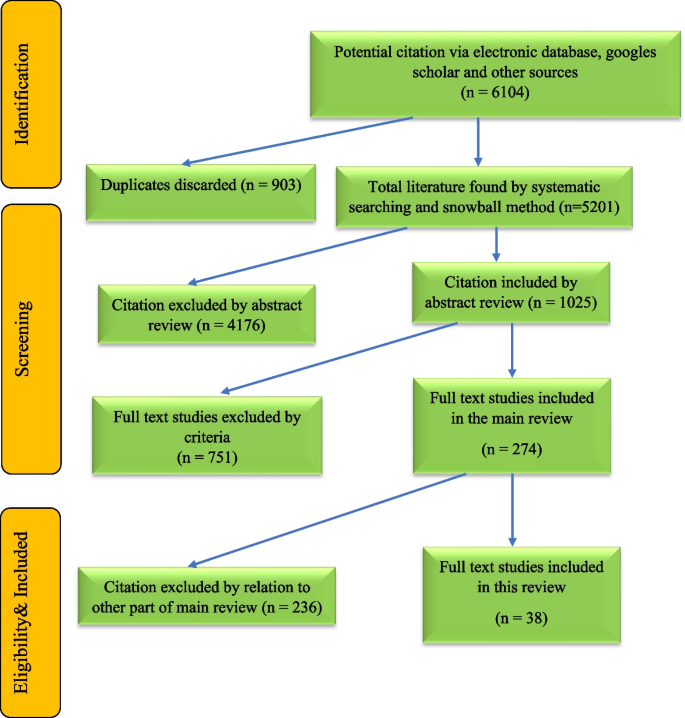
Flow chart diagram of the screening process for included studies on the definitions and characteristics of climate-adaptive cities
Quality appraisal and data extraction
The quality of the articles was evaluated by the researchers using the Critical Appraisal Skills Program (CASP), which provides a systematic way to evaluate the overall quality, reliability, and quality of different study designs [ 25 , 26 ]. CASP provides a structured framework for assessing key aspects such as research methodology, sampling, data analysis, and result reporting.
Each article underwent a detailed evaluation based on specific parameters outlined in the CASP criteria. These parameters encompassed methodological rigor, validity of findings, appropriateness of statistical methods, and the clarity of reporting. The evaluation process resulted in the categorization of articles into three quality groups: low, moderate, and high. Documents and articles that were categorized in the low-quality group were excluded, and articles categorized in the moderate and high-quality groups were included in the study. This thorough quality appraisal process aimed to uphold the integrity and credibility of the included studies, ensuring that the findings synthesized in the systematic review are built upon a foundation of methodologically sound and reliable research.
Data extraction and analysis
The extracted data was recorded in two separate forms. The first form included general characteristics of the article, such as the article's identification number in this study, title of the study, first author of the article, year of the study, type of study, country or city where the study was conducted, the subject matter extracted from the article for the present review, and the study's objective. The second form was related to the extraction of definitions and features of climate-resilient cities. Then, descriptive and thematic analysis was performed for the selected articles and texts. In this study, the authors coded the extracted descriptive information, definitions, and features of climate-resilient cities. Then, similar codes were grouped together. Finally, the grouped findings were analyzed for categorizing these strategies. The accuracy and completeness of the extracted data were discussed by the research team in a group discussion.
During the research, in the first stage of the main review study, 6,104 articles and documents were identified through the search process. After removing 903 cases of duplicate articles, 5,201 articles remained and were reviewed and screened. In the second stage, after studying the titles and abstracts, 4,176 articles were excluded from the retrieved studies. Finally, the full-text of 1,025 articles was reviewed, and based on the inclusion and exclusion criteria, 987 articles were removed. In the end, 38 studies related to the definitions and features of climate-resilient cities were included in the main review study and were examined and analyzed. The results of evaluating the entered articles with the CASP tool showed that 70% of the studies had high quality, and 30% had moderate quality (Table 1 ) (Fig. 1 provides a quick overview of how data was collected).
Descriptive analysis
The reviewed articles were primarily from the United States, accounting for approximately 18.42% of the total. Canada contributed around 7.89%, both individually and as part of a joint article with Saudi Arabia. Australia and England followed closely, with approximately 15.78% and 10.52%, respectively. Thailand comprised about 5.26% of the articles. Other countries collectively contributed approximately 42.13% of the total. Regarding the types of articles, original articles constituted the majority at around 39.4%. Case studies followed, representing about 21.05%, and review articles accounted for 7.8%. Additionally, there was one mixed review and case study, making up approximately 2.6% of the total. Furthermore, two books, two surveys, and two theses were identified, each contributing approximately 5% to the overall distribution.
51.3% of the reviewed articles referred to the characteristics of climate-adaptive cities, 2.3% to the definition of resilience, 20.6% to the definition of adaptation, 10.4% to the definition of climate-adaptive city, 7.7% to the definition of adaption to climate change, and 7.7% to both the definition and characteristics of climate-adaptive cities. The specifications of the entered articles are shown in Table 1 .
Thematic analysis
Given that this study focuses on defining and outlining the characteristics of climate-adaptive cities, the thematic analysis begins by separating codes related to the definitions of adaptive cities from those related to their features. Following this division, codes within each category are further classified into relevant subcategories. Both categories are integral to our understanding, as the definitions aim to articulate what constitutes an adaptive city, while the characteristics elaborate on the specific attributes of such cities. In essence, characteristics serve as complementary elements, providing detailed insights into the nature of adaptive cities.
A total of 75 codes were extracted from 38 articles, including 55 codes related to the characteristics of climate-resilient cities and 20 codes related to definitions. The highest number of codes in the category of features of climate-resilient cities was related to the subcategory of effective resource management with 18 codes. In the category of definitions, the highest number of codes was related to the definition of resilience with 16 codes (Table 2 ). In this review, only four definitions of climate-resilient cities were extracted. It should also be noted that the subcategories of stakeholder participation and knowledge utilization had the lowest number of codes with only three codes among the subcategories in this review. Based on this study, many of the features of climate-resilient cities were extracted from the experiences of resilient cities or cities that have taken steps in this regard.
In none of the reviewed studies, comprehensive definitions and features of climate-resilient cities were thoroughly investigated. Introducing a novel and comprehensive definition of climate-resilient cities, along with categorizing their features and characteristics, holds significant potential for contributing to the existing body of literature. This contribution extends to enhancing the resilience of cities in diverse regions worldwide. Moreover, delineating the features and characteristics of climate-resilient cities in this study proves to be highly efficacious in evaluating the resilience level of cities and urban areas to climate change, while concurrently pinpointing prevailing weaknesses and challenges (Fig. 2 ).
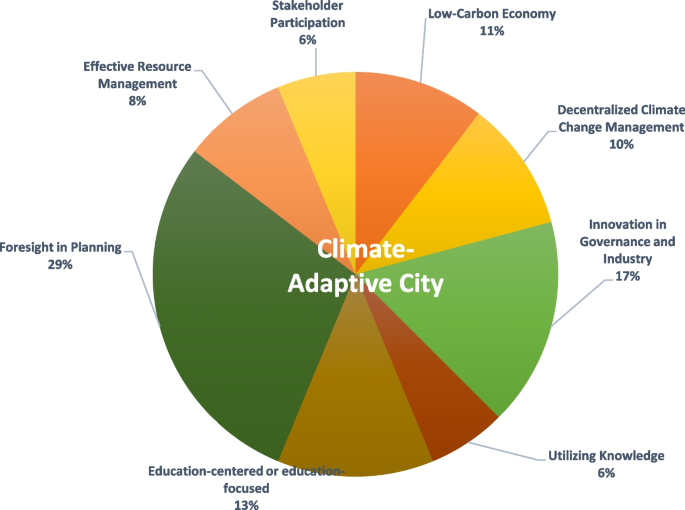
Characteristics and features of climate-adaptive cities identified through systematic review
Definition of climate adaptation and climate-adaptive cities
According to definitions of climate adaptation, it is a multidimensional, location-based challenge [ 43 ]. In fact, adaptation to climate change is a process [ 65 ], and in another definition, it is the coordination between future climate change scenarios and current change strategies and programs [ 33 ]. Some definitions of climate adaptation refer to capacities, which are sustainable and the abilities of communities to cope with environmental changes [ 34 ], or the capacity of a system, society, or community to resist or adapt to a risk, to achieve and maintain a level of performance and structure [ 36 ]. However, the capacity for adaptation is more interpreted as the ability of stakeholders, individuals, groups, and systems [ 30 ]. In another definition, climate adaptation is defined as learning to live with severe weather events, changing weather patterns, and preparing for some unavoidable changes [ 44 ]. From the health perspective, adaptation is a responsive action for public health, which is necessary to prevent, reduce, and manage climate-related risks [ 42 ]. In fact, climate adaptation is the adjustment of natural or human systems to real or potential climate stimuli or their effects, mitigating damages and taking advantage of opportunities [ 35 ] and results in preventing or reducing vulnerability to climate change [ 28 ].
Although there are numerous definitions regarding adaptation to climate change, the definitions of climate-adapted cities are limited and very few. Moreover, none of these definitions are comprehensive, applying solutions to change and reducing the effects in a timely and effective manner before uncontrollable changes occur, and learning from non-adaptive ways used by other cities for defining climate-adapted cities [ 37 ]. In this definition, solutions are generally mentioned, while clarifying this issue is very important. Another definition mainly refers to reducing social vulnerability and emphasizes the importance of bottom-up adaptation [ 39 ], while ignoring other characteristics of climate-adapted cities.
In another definition, a climate-adapted city is defined as a city that can only maintain stability against heat islands [ 32 ]. Although this definition is in line with the global Paris Agreement aimed at global adaptation, it cannot be considered a comprehensive goal. This goal seeks to ensure sufficient adaptation response to the global temperature goal, ultimately leading to sustainable development [ 20 , 66 ]. Finally, a relatively better definition of urban resilience to climate change is as follows: the flexibility of the capacity of individuals, communities, institutions, businesses, and systems within a city to survive, adapt, and grow regardless of the chronic stress and acute shocks they experience [ 39 ]. Therefore, based on the characteristics of climate-adapted cities and the texts reviewed in this study, it can be suggested that a climate-adapted city is a city that, through effective resource management, future-oriented planning, education, knowledge utilization, innovation in governance and industry, decentralized management, and low-carbon economy, leads to adaptation, resilience, sustainability, and flexibility of the capacity of individuals, communities, institutions, businesses, and systems within a city, against all impacts of climate change and reducing the resulting consequences.
Characteristics of climate-adapted cities
In the literature review conducted in this study, no specific study was found to investigate the characteristics of climate-adapted cities. Nevertheless, determining the features, characteristics, and standards of adaptation can be highly effective in assessing its efficiency and categorizing the factors that foster adaptive capacity.
Identifying adaptation criteria is often challenging for development interventions, which can lead to difficulties in classifying whether anything that creates adaptive capacity can be called adaptation [ 67 , 68 ]. Therefore, in this review, all variables and factors that can be considered as characteristics of a climate-adapted city were extracted and categorized in a scientific and systematic manner.
Stakeholder participation
Based on the literature review and considering the effective role of social coordination in resilience [ 59 ], one of the characteristics of climate-adapted cities is the use of participatory techniques, including local stakeholders [ 50 ] and community participation [ 45 , 54 ]. Friend (2010) also considers community participation as a prominent feature of climate-adapted cities [ 54 ]. Although this participation should be comprehensive, Al-Zubari et al. (2018) only referred to the necessity of stakeholder participation in achieving proper water resources [ 45 ]. However, the community-based adaptation process in climate-adapted cities involves engaging other institutional elements in decision-making, ensuring the compatibility of top-down planning with local needs, and using participatory research to facilitate the participation of local communities in shaping adaptation planning processes [ 21 ]. Therefore, it can be said that community-based adaptation can provide an opportunity for people's participation in planning and adaptation activities in a comprehensive and proper manner. Facilitating people's participation leads to understanding and enhancing their awareness of their risk, vulnerability, and resilience to climate change [ 69 ].
Effective resource management
Effective resource management [ 45 , 47 ] and efficient use of limited resources [ 30 , 47 ] are among the most important characteristics of climate-adapted cities. Al-Zubari (2018) [ 45 ] emphasizes the need to create sustainable strategies by estimating the assessment of each household's contribution to global warming based on different lifestyles and climatic conditions in different parts of the world, as well as reducing energy consumption to control greenhouse gas emissions [ 45 ]. This highlights the importance of resource management for achieving effective adaptation. This adaptation strategy may vary across different climates, as individuals' thermal responses to a consistent thermal environment differ from one location to another [ 70 ].
Kilkis S (2016) [ 47 ] also highlights the importance of sustainability, resource management, and the judicious use of resources in climate-adapted cities. He argues that achieving sustainable development in cities requires attention to factors such as energy consumption, carbon dioxide emissions, transportation systems, waste management, water resources, socio-economic capacity, and inter-sectoral sustainability [ 47 ]. Although, the current global progress and sustainable initiatives, as outlined in international frameworks such as the Paris Climate Agreement and the United Nations Sustainable Development Goals (SDGs), are not advancing rapidly or at the expected pace in reducing greenhouse gas emissions and addressing climate change. In other words, advancements in these areas are encountering challenges and obstacle [ 71 ].
In line with the focus on transportation systems, Garg (2001) writes in his article that since greenhouse gases SO2 and NOx in Indian cities are more emitted from industries, focusing on transportation systems as sources of greenhouse gas emissions will have a higher cost-effectiveness in reducing emissions [ 57 ]. Based on the above, it can be concluded that reducing greenhouse gas emissions from urban transportation systems is one of the characteristics of climate-adapted cities, which will also lead to economic benefits.
In his study, Quay R (2010) presents the characteristics of different cities based on a review of their experiences. For example, the city of Denver has developed a water adaptation planning process based on scenarios, while New York City has developed new strategies for water and sewage systems and flood control to enhance their resilience to climate change [ 63 ]. In addition to these, other solutions for effective resource management towards climate adaptation have been mentioned, including: effective energy use management through wind catchers, chimneys, summer spaces with dome or elevated ceilings, courtyards, basements, underground water tanks, and natural refrigerators [ 52 ]; access to vegetation coverage [ 62 ]; centralized sustainable water management [ 55 ]; lifestyle change and proper use of resources [ 30 ]; low-carbon technologies and new energy sources [ 56 ]; focusing on cost-effectiveness in reducing greenhouse gas emissions [ 57 ]; reducing energy consumption to control greenhouse gas emissions [ 45 ]; and the use of renewable energy sources [ 72 ] for climate adaptation in urban areas.
Foresight in planning
One of the most important characteristics of climate-adapted cities is foresight, future prediction, and planning for the future to achieve effective adaptation. In this regard, Alhashmi et al. (2017) emphasizes the need for planning to reduce the use of fossil fuels and use renewable energy sources such as solar, wind, nuclear, and biomass to reduce carbon emissions [ 46 ]. Nanos and Filion (2016) also point to the importance of foresight in climate adaptation planning, considering resilience and executive criteria to assess the flexibility and vulnerability of urban drainage networks in Kingstone. They argue that this can be achieved through forecasting and designing models for hard weather periods to assess how a storm will behave in the future [ 49 ]. Carrero et al. (2013) also mentions the characteristics of foresight, stakeholder participation, and resource management. In his article, he emphasizes considering the economic dimensions in climate change policy planning, identifying stakeholders and their participation, and having a future-oriented approach as effective factors for management [ 50 ]. Additionally, Keenan et al. (2016) includes foresight and collective response to current conditions as characteristics of resilience [ 29 ]. Therefore, foresight, resource efficiency, and proper resource management can be considered essential for cities to achieve climate adaptation.
One of the key characteristics of climate-adaptive cities is education, which involves teaching adaptation strategies at all levels. THP (2017) suggests using social media to increase local farmers' adaptability and learning to enhance resilience to climate change. Therefore, it can be concluded that education and capacity building on effective adaptation strategies and changes in lifestyle and resource use are critical for climate adaptation [ 30 ]. Geirsdóttir et al. (2014) emphasizes the importance of community awareness of their living conditions in climate adaptation. For example, knowledge of past communities in reading weather signs and sea changes had prepared them to react to hazards and raised their preparedness level [ 59 ]. In conclusion, numerous adaptation strategies and solutions can be taught to communities to enhance their participation in climate adaptation. Therefore, one of the characteristics of climate-adaptive communities is to pay attention to the following while teaching adaptation strategies: using learning methods and teaching techniques appropriate for the community's culture and awareness level, using social media capacity, using virtual spaces and modern teaching methods, and engaging local leaders and educators for education.
Utilizing knowledge
The gap between knowledge and action in the field of climate change has made it difficult to understand and establish a relationship with it [ 73 ]. Tapan Kumar Dhar (2016) [ 35 ] believes that using indigenous, interdisciplinary and community-based knowledge along with governmental collaborations, as well as integrating physical and socio-environmental characteristics, are necessary for successful adaptation [ 35 ]. Therefore, it seems that the use of indigenous knowledge and interdisciplinary research [ 35 ], is one of the necessities for achieving climate-adaptive cities. Community awareness of their living conditions can play a significant role in identifying and interpreting environmental changes, which can enhance their preparedness and response to climate change hazards [ 59 ]. In this regard, Odemerho emphasizes the importance of utilizing the experiences and human knowledge of flood-prone areas to adapt to floods and recognize the dominant type of flood and its root causes [ 74 , 75 ]. Overall, it can be inferred that utilizing knowledge, especially interdisciplinary, local, and indigenous knowledge, and utilizing past experiences are characteristics of climate-adaptive cities and can enhance their awareness, preparedness, and adaptation to climate change.
Innovation in governance and industry
Governance [ 30 ] and industry play a crucial role in enhancing the resilience of communities to climate change, and innovation in these areas is one of the key characteristics of climate-adaptive cities. For example, Guangkuo Gao (2015) [ 56 ] considers the development of low-carbon policies through industrial structure, innovation in governance, low-carbon technology, incentive mechanisms, and new energy supply as characteristics of climate-adaptive cities [ 56 ]. Based on the review conducted in this study, other examples of innovation in governance and industry include: increasing the resilience of local water resources with a bottom-up approach in decision-making [ 60 ], low-energy consumption through sustainable house design [ 61 ], attention to energy and carbon dioxide emissions, transportation systems, waste management, water, social-economic capacity, and intersectoral sustainability for achieving sustainable development in cities [ 47 ], and attention to resistance and capacity building [ 51 ]. Therefore, the adaptation of climate-adaptive cities requires the creation, expansion, or imitation of innovative strategies and plans for climate adaptation in governance and industry. This issue, including some insights on corporate social responsibility, should receive the attention and support of policymakers and industry leaders.
Decentralized climate change management
Another characteristic of climate-adaptive cities is decentralized management. One example of this is decentralized urban risk management [ 53 , 58 ]. For instance, decentralization of urban risk management in the central system in Vietnam is an example of decentralization [ 53 ]. One aspect of climate adaptation is decentralized planning based on local risk assessments. Moreover, decentralized management signifies the involvement and participation of communities in decision-making. In this regard, Gonzales (2017) argues that a bottom-up approach in decision-making can help increase the resilience of local water resources [ 60 ]. Furthermore, increasing the capacity of local governments to assist the adaptive growth of people, especially farmers, to environmental changes has been recommended [ 30 ].
- Low-carbon economy
One of the prominent features of climate-adaptive cities is a focus on a low-carbon economy [ 64 ]. Li (1995) identifies the creation of green jobs, the possibility of transforming existing jobs into green jobs, and the ability to continue working under lower consumption conditions as examples of a low-carbon economy [ 76 ]. In this regard, it is also possible to mention the imposition of taxes on carbon dioxide, its trading, and investment in wind, solar, water, biomass, and other types of renewable energy [ 56 ] should be promoted. Although recent studies on the transition to a global low-carbon economy or decarbonization are not encouraging, as both human and natural carbon dioxide emissions are increasing due to human factors [ 77 ], attention to this issue is essential for climate-adaptive cities. In summary, a low-carbon economy is critical for reducing greenhouse gas emissions and addressing climate change. Climate-adaptive cities must prioritize the development of a low-carbon economy to reduce their carbon footprint and promote sustainability.
The main limitations of this study were associated with the extended duration of the project. This study was part of a larger systematic review. Due to the substantial scale of the overarching project, the execution time of the work and its completion extended. While the implementation date is specified in the methodology, the prolonged duration can be justified to some extent given the significance of the climate change issue and the contemporary nature of the topic. Another limitation pertained to accessing articles. Some articles were not readily available, prompting researchers to attempt retrieval through contacting authors, purchasing articles, or utilizing accessible academic databases.
Based on the definitions and characteristics examined in this systematic review, a climate-adaptive city is a city that, through effective resource management, forward-thinking planning, education, knowledge utilization, innovation in governance and industry, decentralized management, and low-carbon economy, can adapt, be resilient, sustainable, and flexible in the face of all possible climate change impacts and minimize their negative consequences on the capacity of individuals, communities, institutions, businesses, and systems within a city. It should be noted that all actions must be in line with the economic, social, cultural, and geographical characteristics of each region separately and must be based on sustainable development.
Forward-thinking planning in this regard must be community-based and resource management with a bottom-up approach in decision-making. In a climate-adaptive city, the participation of all stakeholders and local communities must be facilitated in a way that ultimately leads to reduced social vulnerability and economic efficiency.
Conclusively, future research in this field should prioritize the issue of carbon justice, a pivotal element in achieving sustainability and resilience in climate-adaptive cities. Additionally, we recommend conducting foundational studies to thoroughly explore decision-makers' attitudes, contributing to the development of appropriate protocols, principles, and urban plans. Subsequent research can extensively investigate the roles of corporate entities, academia, and industries in climate-adaptive city development. In conclusion, this study underscores the urgent need for a more comprehensive approach to climate change adaptation in urban planning.
Availability of data and materials
The datasets used and/or analyzed during the current study are available from the corresponding author on reasonable request.
Rosenzweig C, Solecki WD, Hammer SA, Mehrotra S. Climate change and cities: First assessment report of the urban climate change research network. United States of America, New York: Cambridge University Press; 2011.
Sharifi A. Co-benefits and synergies between urban climate change mitigation and adaptation measures: a literature review. Sci Total Environ. 2021;750:141642.
Article CAS PubMed Google Scholar
Alabsi AAN, Wu Y, Koko AF, Alshareem KM, Hamed R. Towards climate adaptation in cities: indicators of the sustainable climate-adaptive urban fabric of traditional cities in West Asia. Appl Sci. 2021;11(21):10428.
Article CAS Google Scholar
Singh C, Madhavan M, Arvind J, Bazaz A. Climate change adaptation in Indian cities: a review of existing actions and spaces for triple wins. Urban Climate. 2021;36:100783.
Article Google Scholar
Almusaed A, Almssad A, Homod RZ, Yitmen I. Environmental profile on building material passports for hot climates. Sustainability. 2020;12(9):3720.
Zhang J, Khoshbakht M, Liu J, Gou Z, Xiong J, Jiang M. A clustering review of vegetation-indicating parameters in urban thermal environment studies towards various factors. J Therm Biol. 2022;110:103340.
Article PubMed Google Scholar
Organization WM. Causes of climate change Geneva: World Health Organization 2009 Agust. 2009 Agust. Available from: Available from: https://www.ipcc.ch/ .
Hughes TP, Baird AH, Bellwood DR, Card M, Connolly SR, Folke C, et al. Climate change, human impacts, and the resilience of coral reefs. Science. 2003;301(5635):929–33.
Portier CJ, Tart KT, Carter SR, Dilworth CH, Grambsch AE, Gohlke J, et al. A human health perspective on climate change: a report outlining the research needs on the human health effects of climate change. J Curr Issues Global. 2013;6(4):621.
Google Scholar
World Health Organization. Protecting health from climate change: connecting science, policy and people. 2009.
Heaviside C, Macintyre H, Vardoulakis S. The urban heat island: implications for health in a changing environment. Curr Environ Health Rep. 2017;4:296–305.
Dasgupta S, Laplante B, Murray S, Wheeler D. Exposure of developing countries to sea-level rise and storm surges. Clim Change. 2011;106:567–79.
Adger WN, Lorenzoni I, O'Brien KL. Adapting to climate change: Thresholds, values, governance. United States of America, New York: Cambridge University Press; 2009.
Glickman TS. Glossary of meteorology: American Meteorological Soc. 2000.
Salehi S, Ardalan A, Garmaroudi G, Ostadtaghizadeh A, Rahimiforoushani A, Zareiyan A. Climate change adaptation: a systematic review on domains and indicators. Natural Hazards. 2019;96:521-50.
Friel S, Bowen K, Campbell-Lendrum D, Frumkin H, McMichael AJ, Rasanathan K. Climate change, noncommunicable diseases, and development: the relationships and common policy opportunities. Annu Rev Public Health. 2011;32:133–47.
McMichael AJ C-LD, Corvalán CF, Ebi KL, Githeko A, Scheraga JD, et al. Climate change and human health: risks and responses. Geneva: World Health Organization; 2003.
Mobarghaei N, Mokhtari Z. Applying ecosystem-based adaptation approach in building climate-resilient cities. Popularization Sci. 2018;8(2):125–45.
Kou Y, Xian D, Liu Y, Chen J, Wang C, Cheng B, et al. Factors affecting urban climate at different times of the day in China: a case study in Yibin, a riverside mountain city. Nat Based Solutions. 2022;2:100043.
Singh C, Iyer S, New MG, Few R, Kuchimanchi B, Segnon AC, et al. Interrogating ‘effectiveness’ in climate change adaptation: 11 guiding principles for adaptation research and practice. Climate Dev. 2022;14(7):650–64.
Archer D, Almansi F, DiGregorio M, Roberts D, Sharma D, Syam D. Moving towards inclusive urban adaptation: approaches to integrating community-based adaptation to climate change at city and national scale. Climate Dev. 2014;6(4):345–56.
Zhang J, Gou Z, Cheng B, Khoshbakht M. A study of physical factors influencing park cooling intensities and their effects in different time of the day. J Therm Biol. 2022;109:103336.
Campbell-Lendrum D, Corvalan C. Climate change and developing-country cities: implications for environmental health and equity. J Urban Health. 2007;84:i109–17.
Reckien D, Flacke J, Olazabal M, Heidrich O. The influence of drivers and barriers on urban adaptation and mitigation plans—an empirical analysis of European cities. PLoS ONE. 2015;10(8):e0135597.
Article PubMed PubMed Central Google Scholar
Jung S, Uttley L, Huang J. Housing with care for older people: a scoping review using the CASP assessment tool to inform optimal design. HERD: Health Environ Res Design J. 2022;15(4):299–322.
Monaghesh E, Hajizadeh A. The role of telehealth during COVID-19 outbreak: a systematic review based on current evidence. BMC Public Health. 2020;20:1–9.
Burch S. In pursuit of resilient, low carbon communities: An examination of barriers to action in three Canadian cities. Energy Policy. 2010;38(12):7575-85.
Abunnasr Y, Hamin EM, Brabec E. Windows of opportunity: Addressing climate uncertainty through adaptation plan implementation. J Environ Planning Manage. 2015;58(1):135–55.
Keenan JM, King DA, Willis D. Understanding conceptual climate change meanings and preferences of multi-actor professional leadership in New York. J Environ Plan Policy Manag. 2016;18(3):261–85.
Le THP. Developing adaptive capacity in times of climate change in central rural Vietnam: exploring smallholders’ learning and governance: Wageningen University; 2017.
Pelling M. Adaptation to climate change: from resilience to transformation. Routledge; 2010.
Cochran FV, Brunsell NA. Biophysical metrics for detecting more sustainable urban forms at the global scale. Int J Sustain Built Environ. 2017;6(2):372–88.
Cooper J, Lemckert C. Extreme sea-level rise and adaptation options for coastal resort cities: a qualitative assessment from the Gold Coast. Australia Ocean Coastal Manag. 2012;64:1–14.
De Vet E. Experiencing and responding to everyday weather in Darwin, Australia: the important role of tolerance. Weather Climate Soc. 2017;9(2):141–54.
Dhar TK. Urban design and planning in adapting to climate change: Advances, applications, and challenges. 2016.
Hammond MJ, Chen AS, Djordjević S, Butler D, Mark O. Urban flood impact assessment: a state-of-the-art review. Urban Water Journal. 2015;12(1):14–29.
Chapman R, Howden-Chapman P, Capon A. Understanding the systemic nature of cities to improve health and climate change mitigation. Environ Int. 2016;94:380–7.
Gowan ME, Kirk RC, Sloan JA. Building resiliency: a cross-sectional study examining relationships among health-related quality of life, well-being, and disaster preparedness. Health and quality of life outcomes. 2014;12:1-17.
Spaans M, Waterhout B. Building up resilience in cities worldwide–Rotterdam as participant in the 100 resilient cities programme. Cities. 2017;61:109–16.
Reed MS, Podesta G, Fazey I, Geeson N, Hessel R, Hubacek K, et al. Combining analytical frameworks to assess livelihood vulnerability to climate change and analyse adaptation options. Ecological Economics. 2013;94:66-77.
Rosenzweig C, Solecki W. Hurricane Sandy and adaptation pathways in New York: Lessons from a first-responder city. Global Environmental Change. 2014;28:395-408.
Poutiainen C, Berrang-Ford L, Ford J, Heymann J. Civil society organizations and adaptation to the health effects of climate change in Canada. Public Health. 2013;127(5):403–9.
Pietrapertosa F, Khokhlov V, Salvia M, Cosmi C. Climate change adaptation policies and plans: a survey in 11 South East European countries. Renew Sustain Energy Rev. 2018;81:3041–50.
Henderson K. Briefing: adapting to a changing climate. Proceed Institution Civil Engineers-Urban Design Planning. 2010;163(2):53–8.
Al-Zubari WK, El-Sadek AA, Al-Aradi MJ, Al-Mahal HA. Impacts of climate change on the municipal water management system in the Kingdom of Bahrain: vulnerability assessment and adaptation options. Clim Risk Manag. 2018;20:95–110.
AlHashmi M, Haider H, Hewage K, Sadiq R. Energy efficiency and global warming potential in the residential sector: comparative evaluation of Canada and Saudi Arabia. J Archit Eng. 2017;23(3):04017009.
Kilkis S. Sustainable development of energy, water and environment systems index for Southeast European cities. J Clean Prod. 2016;130(1):222-34.
Ali G, Pumijumnong N, Cui S. Decarbonization action plans using hybrid modeling for a low-carbon society: the case of Bangkok Metropolitan Area. J Clean Prod. 2017;168:940-51.
Nanos MG, Filion Y. editors. risk-based performance assessment of stormwater drainage networks under climate change: a case study in the City of Kingston, ON. World Environ Water Res Congress. 2016;2016:73–81.
Carrero R, Navas F, Malvárez G, Cáceres F. Participative future scenarios for integrated coastal zone management. J Coastal Res. 2013;65(10065):898–903.
Liao K-H, Le TA, Van Nguyen K. Urban design principles for flood resilience: learning from the ecological wisdom of living with floods in the Vietnamese Mekong Delta. Landsc Urban Plan. 2016;155:69–78.
Abdolhoseyni J. Adaptability of design of residential houses in Tabriz and Baku with the native culture and climate. Monthly Sci J Bagh-e Nazar. 2011;8(18):136.
Matthews J. Disaster Resilience of critical water infrastructure systems. J Struct Eng. 2015;142:C6015001.
Friend R, Jarvie J, Reed SO, Sutarto R, Thinphanga P, Toan VC. Mainstreaming urban climate resilience into policy and planning; reflections from Asia. Urban Climate. 2014;7:6–19.
Furey S, Lutyens B. Developing an integrated water management strategy to overcome conflicts between urban growth, water infrastructure and environmental quality: a case study from Ashford. Kent Water Environ J. 2008;22(1):42–53.
Gao G, Chen S, Yang J. Carbon emission allocation standards in China: a case study of Shanghai city. Energ Strat Rev. 2015;7:55–62.
Garg A, Shukla P, Bhattacharya S, Dadhwal V. Sub-region (district) and sector level SO2 and NOx emissions for India: assessment of inventories and mitigation flexibility. Atmos Environ. 2001;35(4):703–13.
Garschagen M. Decentralizing urban disaster risk management in a centralized system? Agendas, actors and contentions in Vietnam. Habitat Int. 2016;52:43–9.
Geirsdóttir GE, Gísladóttir G, Jónsdóttir Á. Coping with storm surges on the Icelandic south coast: A case study of the Stokkseyri village. Ocean Coast Manag. 2014;94:44–55.
Gonzales P, Ajami NK. An integrative regional resilience framework for the changing urban water paradigm. Sustain Cities Soc. 2017;30:128–38.
Tapsuwan S, Mathot C, Walker I, Barnett G. Preferences for sustainable, liveable and resilient neighbourhoods and homes: a case of Canberra. Australia Sustainable Cities Soc. 2018;37:133–45.
Tayyebi A, Jenerette GD. Increases in the climate change adaption effectiveness and availability of vegetation across a coastal to desert climate gradient in metropolitan Los Angeles, CA, USA. Sci Total Environ. 2016;548:60–71.
Quay R. Anticipatory governance: A tool for climate change adaptation. J Am Plann Assoc. 2010;76(4):496–511.
Lee C. What do we know? What do we need to know? Women’s Health Australia: Progress on the Australian longitudinal study on women’s health, 1995− 2000. 2001.
Peling SWY. Perbedaan Pengaruh Metode Latihan Beban Leg-Press dan Sqat terhadap Peningkatan Prestasi Lari 100 Meter Ditinjau dari Waktu Reaksi (Studi Eksperimen pada Mahasiswa Putra Pembinaan Prestasi Atletik Fakultas Olahraga dan Kesehatan Universitas Pendidikan: UNS (Sebelas Maret University). 2011.
Craft B, Fisher S. Measuring the adaptation goal in the global stocktake of the Paris agreement. Climate Policy. 2018;18(9):1203–9.
Owen G. What makes climate change adaptation effective? A systematic review of the literature. Glob Environ Chang. 2020;62:102071.
Schipper ELF, Tanner T, Dube OP, Adams K, Huq S. The debate: Is global development adapting to climate change? World DeveloP Perspect. 2020;18:100205.
Nirupama N, Maula A. Engaging public for building resilient communities to reduce disaster impact. Nat Hazards. 2013;66:51–9.
Zhang J, Guo W, Cheng B, Jiang L, Xu S. A review of the impacts of climate factors on humans’ outdoor thermal perceptions. J Therm Biol. 2022;107:103272.
He B-J, Wang J, Zhu J, Qi J. Beating the urban heat: Situation, background, impacts and the way forward in China. Renew Sustain Energy Rev. 2022;161:112350.
Sakr D, Baas L, El-Haggar S, Huisingh D. Critical success and limiting factors for eco-industrial parks: global trends and Egyptian context. J Clean Prod. 2011;19(11):1158–69.
Mendizabal M, Feliu E, Tapia C, Rajaeifar MA, Tiwary A, Sepúlveda J, et al. Triggers of change to achieve sustainable, resilient, and adaptive cities. City Environ Interactions. 2021;12:100071.
Odemerho FO. Building climate change resilience through bottom-up adaptation to flood risk in Warri. Nigeria Environment and Urbanization. 2015;27(1):139–60.
Yari A, Ostadtaghizadeh A, Ardalan A, Zarezadeh Y, Rahimiforoushani A, Bidarpoor F. Risk factors of death from flood: Findings of a systematic review. Journal of environmental health science and engineering. 2020;18(2):1643-53.
Lee C. What do we know? What do we need to know. Women’s Health Australia: Progress on the Australian longitudinal study on women’s health. 2000.
Lugo-Morin DR. Global future: low-carbon economy or high-carbon economy? World. 2021;2(2):175–93.
Download references
Acknowledgements
This study was carried out with the support of the Department of Health in Emergencies and Disasters, Climate Change and Health Research Group at the Institute for Environmental Research, and School of Public Health at Tehran University of Medical Sciences.
The present study was funded by Tehran University of Medical Sciences. The funding sources did not participate in the study design, data collection and analysis, decision to publish, or manuscript preparation.
Author information
Abbas Ostadtaghizadeh
Present address: Department of Health in Emergencies and Disasters, School of Public Health, Tehran University of Medical Sciences, Poorsina Ave, Tehran, 14177-43578, I.R, Iran
Authors and Affiliations
Social Determinants of Health Research Center, Research Institute for Health Development, Kurdistan University of Medica Sciences, Sanandaj, Iran
Arezoo Yari
Department of Health in Emergencies and Disasters, School of Public Health, Tehran University of Medical Sciences, Poorsina Ave, Tehran, 14177-43578, I.R, Iran
Alireza Mashallahi
Center for Climate Change and Health Research (CCCHR), Dezful University of Medical Sciences, Dezful, Iran
Hamidreza Aghababaeian
International Institute of Health Management Research, Delhi, India
Nidhi Yadav
Social Determinants of Health Research Center, Isfahan University of Medical Sciences, Isfahan, Iran
Arefeh Mousavi
Department of Nursing, Faculty of Nursing and Midwifery, Tehran Medical Sciences, Islamic Azad University, Tehran, Iran
Shiva Salehi
Department of Health in Emergencies and Disasters, School of Medicine, Kurdistan University of Medical Sciences, Sanandaj, Iran
Spiritual Health Research Center, Iran University of Medical Sciences, Tehran, Iran
Mohsen Nouri
Climate Change and Health Research Center (CCHRC), Institute for Environmental Research (IER), Tehran University of Medical Sciences, Tehran, Iran
You can also search for this author in PubMed Google Scholar
Contributions
AH, and AOT researched the background for the project and AY, HA, MN, AM, SHS, and AOT contributed to performing the study. AM, HA, AY, NY, and AOT analyzed and interpreted the data. AY, AOT, and NY. wrote and edited the main manuscript. AY prepared Figures 1 and 2. All the authors reviewed and approved the final manuscript.
Corresponding author
Correspondence to Abbas Ostadtaghizadeh .
Ethics declarations
Ethics approval and consent to participate.
This study was carried out in conformity with the principles of the Declaration of Helsinki and was approved by the Ethics Committees of Tehran Universities of Medical Sciences (Iran) under the license number IR.TUMS.VCR.REC.36797.46.04.96.
Consent for publication
Not applicable.
Competing interests
The authors declare no competing interests.
Additional information
Publisher’s note.
Springer Nature remains neutral with regard to jurisdictional claims in published maps and institutional affiliations.
Rights and permissions
Open Access This article is licensed under a Creative Commons Attribution 4.0 International License, which permits use, sharing, adaptation, distribution and reproduction in any medium or format, as long as you give appropriate credit to the original author(s) and the source, provide a link to the Creative Commons licence, and indicate if changes were made. The images or other third party material in this article are included in the article's Creative Commons licence, unless indicated otherwise in a credit line to the material. If material is not included in the article's Creative Commons licence and your intended use is not permitted by statutory regulation or exceeds the permitted use, you will need to obtain permission directly from the copyright holder. To view a copy of this licence, visit http://creativecommons.org/licenses/by/4.0/ . The Creative Commons Public Domain Dedication waiver ( http://creativecommons.org/publicdomain/zero/1.0/ ) applies to the data made available in this article, unless otherwise stated in a credit line to the data.
Reprints and permissions
About this article
Cite this article.
Yari, A., Mashallahi, A., Aghababaeian, H. et al. Definition and characteristics of climate-adaptive cities: a systematic review. BMC Public Health 24 , 1200 (2024). https://doi.org/10.1186/s12889-024-18591-x
Download citation
Received : 25 September 2023
Accepted : 14 April 2024
Published : 30 April 2024
DOI : https://doi.org/10.1186/s12889-024-18591-x
Share this article
Anyone you share the following link with will be able to read this content:
Sorry, a shareable link is not currently available for this article.
Provided by the Springer Nature SharedIt content-sharing initiative
- Climate change
- Climate-adaptive cities
- Resource management
BMC Public Health
ISSN: 1471-2458
- Submission enquiries: [email protected]
- General enquiries: [email protected]

IMAGES
VIDEO
COMMENTS
Our online article review generator is an excellent solution for crafting comprehensive reviews. It offers in-depth analysis while ensuring that the main ideas from the article are effectively highlighted. The tool allows students to focus on critical evaluation and personal insights rather than getting bogged down in summarization.
First, conduct a search on Google about your topic, and then select 5 to 6 different articles in your browser. Copy the content required from each of the articles and create a fresh draft. Go to our AI Article Rewriter Tool and paste your content or article in the box provided. When you press the "Basic Rewrite" button, you will see that our AI ...
Article rewriting is the process of expressing information in a new way. Article rewriting is to make changes in a text by replacing words, phrases, sentences, and sometimes whole paragraphs to make the text look unique and more engaging. The difficulty is when you have to change every suitable word to make it unique while keeping the main idea ...
Learn how to use SciSpace, Mendeley, Zotero, Sysrev, and CiteThisForMe to find, read, and cite academic articles for your research paper. These tools can help you save time, improve productivity, and enhance your literature review skills.
Rewrite articles by following the simple steps given below: Paste or Upload a document (.txt, .doc, .pdf, .odt, .rtf, and .tex.) in the rewriter tool. Select your desired rewriting mode from the drop-down menu. Click on the "Rewrite Article" button to generate suggestions/synonyms based on your content. If you're unsatisfied with the final ...
6. Consensus. Researchers to work together, annotate, and discuss research papers in real-time, fostering team collaboration and knowledge sharing. 7. RAx. Researchers to perform efficient literature search and analysis, aiding in identifying relevant articles, saving time, and improving the quality of research. 8.
3. Identify the article. Start your review by referring to the title and author of the article, the title of the journal, and the year of publication in the first paragraph. For example: The article, "Condom use will increase the spread of AIDS," was written by Anthony Zimmerman, a Catholic priest.
Refresh your memory. Quickly remind yourself of the key facts and findings before a lecture or meeting with your supervisor. Synthesize your insights. Export to other apps. Export your flashcards to a range of file formats that are compatible with lots of research and productivity apps.
Enago Read - Research assistant tool helps with literature review, critical analysis, summarizing, and more. Refer to help Enago Read get more feedback to keep the magic going! In appreciation, get $12 credits.
AI-powered. Reading Assistant. A Reading Space to Ideate, Create Knowledge, and Collaborate on Your Research. Smartly organize your research. Receive recommendations that cannot be ignored. Collaborate with your team to read, discuss, and share knowledge. Get Started. No credit card required.
Using MAXQDA as your literature review software enables you to employ a vast range of procedures for the quantitative evaluation of your material. You can sort sources according to document variables, compare amounts with frequency tables and charts, and much more. Make sure you don't miss the word frequency tools of MAXQDA's add-on module ...
Welcome to Jenni AI, the ultimate tool for researchers and students. Our AI Literature Review Generator is designed to assist you in creating comprehensive, high-quality literature reviews, enhancing your academic and research endeavors. Say goodbye to writer's block and hello to seamless, efficient literature review creation.
Generate comprehensive and well-structured literature reviews with AI. Taskade offers a dynamic and customizable tool to access, edit and share existing literature on any research topic.
Our plagiarism checker, AI Detector, Citation Generator, proofreading services, paraphrasing tool, grammar checker, summarizer, and free Knowledge Base content are designed to help students produce quality academic papers. We make every effort to prevent our software from being used for fraudulent or manipulative purposes.
Creates a comprehensive academic literature review with scholarly resources based on a specific research topic. HyperWrite's AI Literature Review Generator is a revolutionary tool that automates the process of creating a comprehensive literature review. Powered by the most advanced AI models, this tool can search and analyze scholarly articles, books, and other resources to identify key themes ...
Scholarcy's AI summarization tool is designed to generate accurate, reliable article summaries. Our summarizer tool is trained to identify key terms, claims, and findings in academic papers. These insights are turned into digestible Summary Flashcards. The knowledge extraction and summarization methods we use focus on accuracy.
The following is a brief summary of seven free and open source software tools described in that article that will make your next literature review much easier. 1. GNU Linux. Most literature reviews are accomplished by graduate students working in research labs in universities.
QuillBot's AI-powered paraphrasing tool will enhance your writing. Your words matter, and our paraphrasing tool is designed to ensure you use the right ones. With unlimited Custom modes and 9 predefined modes, Paraphraser lets you rephrase text countless ways. Our product will improve your fluency while also ensuring you have the appropriate ...
Our article rewriter tool's functionalities are all free to use, so there's no excuse not to make use of it. · Safe and secure. Our article rewriter is 100 percent secure and reliably generates genuine and precise results. "Precise results" implies that each changed text is not only free of plagiarism but also better in reading and understanding.
Our AI text rewriter eliminates inefficiency and time-consuming problems that people might face with other tools or manual methods. This rewrite tool generates and displays results quickly for every user. Grammar Check. With this online article rewriter tool, you can check the grammatical issues.
Use an Online Free Article Rewriter Tool. The second way is much easier, simpler, and you do not need to hire anyone for it. You can do it yourself, at home, and with ease. Rewritertools.com provides you high-quality, unique content in just a few minutes. Rewriter tool Uses two different methods to deliver you unique content - The first ...
5 Different Rewriting Modes. Our article rewriting tool comes with five different modes - all of which have a different working. Let's take a look at each mode in detail: Word Changer. The Word Changer mode of our essay rewriter is made to target only words in the input text and replace them with their synonyms.
Authors can access this tool via the 'Suggest Reviewers' link next to submitted and published articles in the Submissions section in My Research. As this is an automatically generated list of potential reviewers, authors must use their own judgement to determine if the suggested reviewers have the appropriate expertise to review the article.
The article introduces some of the best AI tools for postgraduate research in 2024, and how they can help researchers with literature review. Explore these top AI tools helpful for revolutionizing postgraduate research in 2024 Postgraduate research is a challenging and rewarding endeavor that requires.
The new tool, a plug-in released on 13 April by RedacTek, based in Oakland, California, ... Plagiarism in peer-review reports could be the 'tip of the iceberg' ...
As AI becomes more powerful, it faces a major trust problem. Consider 12 leading concerns: disinformation, safety and security, the black box problem, ethical concerns, bias, instability ...
Dyson Airstrait Review: A Near-Perfect Tool For Managing Frizz. Sholeen Damarwala. Forbes Staff. Forbes Vetted. May 1, 2024, 08:22pm EDT. Share to Facebook; Share to Twitter; Share to Linkedin;
An earlier version of this article misstated the legal status of abortion in Utah. As of 4 p.m. on June 24, the state attorney general had issued a statement saying the state's abortion ban had ...
The results of evaluating the entered articles with the CASP tool showed that 70% of the studies had high quality, ... Case studies followed, representing about 21.05%, and review articles accounted for 7.8%. Additionally, there was one mixed review and case study, making up approximately 2.6% of the total. Furthermore, two books, two surveys ...
This article explores the top remote support tools dominating the industry in 2024. We'll dive into their key features, functionalities, and benefits to help you make an informed decision. ... Technicians can review the steps taken during a remote session, and RemotePC provides activity reporting, which tracks all actions performed on the ...